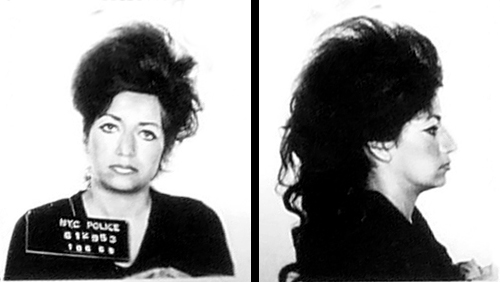

RETURN TO MAIN PAGE ~ Go to: American Werewolf
“For murder, though it have no tongue, will speak
With most miraculous organ.”
~ Hamlet ~
"MURDER WILL OUT": HOW I CAME TO FIND LORRAIN MCGRAW
The case of Lorraine McGraw came across my way in December 2020, in
the most strange and circuitous way, completely unexpected. It would become
the first murder I ever solved in my life, and something I had never set out
to do, a wondrous thing such as that.
When Lorraine was murdered in the winter of 1970 and then promptly forgotten by the police, the media, and much of her family, I was a fourteen year-old boy in Grade Eight; I was an old man of sixty-five when in 2021 I brought her case to life and raised her to memory, and I solved her murder, and my investigative partner Jennifer Weiss and I got it closed in 2022. (Solving cases is very easy. Getting them closed is the bitch hard part; to convince the perpetrator to confess, to persuade investigative and prosecutorial bureaucracies to move to officially close a case or in rare occasions prosecute it. It's a Sisyphus slope you fight your way up and it is often a dishearteningly long and a slippery one.)

I am telling Lorraine's story here, because nobody else is telling it.
I am telling it in order that somebody in the future can tell her story again, much better than I can.
But this story here is my story, not only in the sense that I am writing or telling it, or even witnessed it; I both made it happen and actually lived its ending, the final episode of closing out Lorraine's life and death by murder; its conclusion with the two promises I made and I delivered on to her granddaughter Sonia Ruiz McGraw:
1. That I would solve and ensure Rockland County closed her grandmother's unsolved murder;
2. That I put on the public record her life and death, including in my book on the Richard Cottingham murders.
Her murder waited 52 years to be resolved, and her story 55 years to be told for the first time in news media and in my book and in these uncorrected manuscript advance preview excerpts.
The story I tell is a personal one from when I first learned in January 2021 that Lorraine McGraw existed, to when I managed to get her case closed and memorialized on the public record eighteen months later in August 2022, and everything that happened in between, and everybody whose path I crossed or shared or brother-and-sister-in-arms partnered with on this odyssey.
Otherwise, everything else is factually documented, any errors of fact are my responsibility alone.
This is what happened.
This is how it started.
It was being run from Salomon's desk at the DEA-NYPD-NYSP Joint Task Force in New York, headquartered in the DEA's bunker in Chelsea off the High Line.
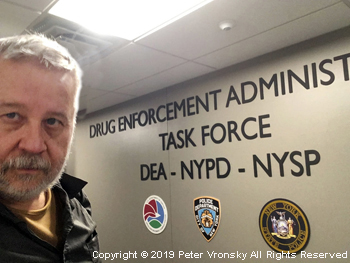
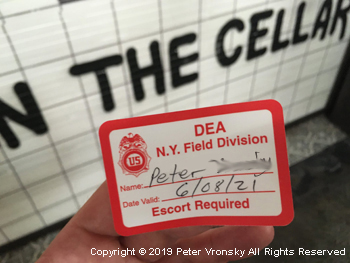
Yan had been assigned a desk job in his last year before retiring, with not much to do, but a burning passion for cold cases and missing persons kept him up nights. He came on board in November 2020 with Jennifer Weiss and me to try to help everybody close some of the 85 to 100 unsolved murders that serial killer Richard Cottingham, the Torso Serial Killer, was very plausibly claiming to have perpetrated from 1967 to 1980. (I personally believe, since 1963.)
We assembled a list of about twenty-five cases across New York City, Long Island and Hudson Valley regions.
Lorrain McGraw was not on our list.
None of us knew she
existed in December 2020, when Yan and Conor sat down with Cottingham to
interview him.
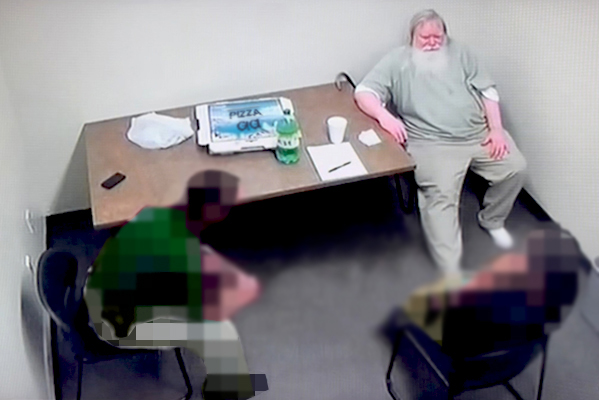
Detective Conor Fitzgerald had been brought in a few weeks earlier, and was interested in talking to Cottingham about an old case, a 1979 murder of 17-year-old Shirley Smith in Nyack, NY, brutally stabbed to death in the early morning hours in a parking lot of a Nyack bar and restaurant.
This was unusual because her murder was a closed case!
The killer had been caught and convicted and sent to prison in 1980!
The perpetrator of Smith's murder - seventeen-year old necrophile Amer Zada, had been arrested at the scene of the crime, attempting to sodomize Shirley's corpse behind a dumpster in the parking lot where he dragged her after stabbing her twenty-four times.
A routine village police patrol was dispatched to respond to calls from neighbors complaining of a woman screaming. On their arrival at the scene, they came upon a macabre tableau lit up by the headlights of their car. Zada was on top of Shirley Smith with his pants down to his knees, erect penis out, covered in her blood, attempting to anally rape her corpse. He attempted to flee like a monkey up a chain link fence but was quickly apprehended by the shocked small-town cops who had never seen anything like this in Nyack - other than in a horror movies.
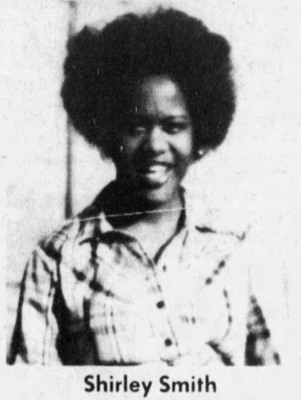
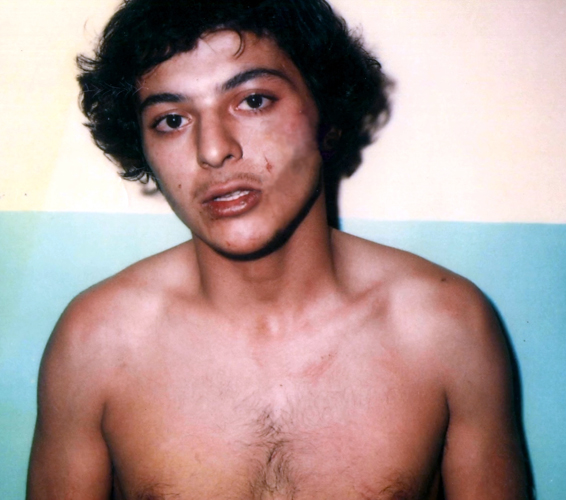
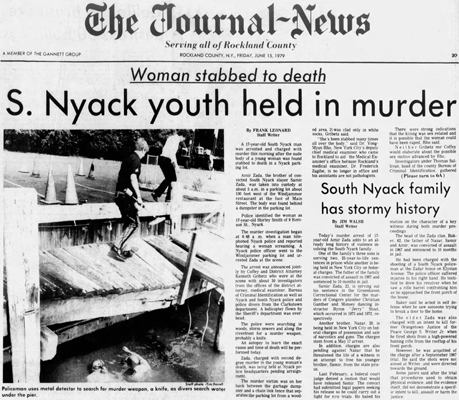
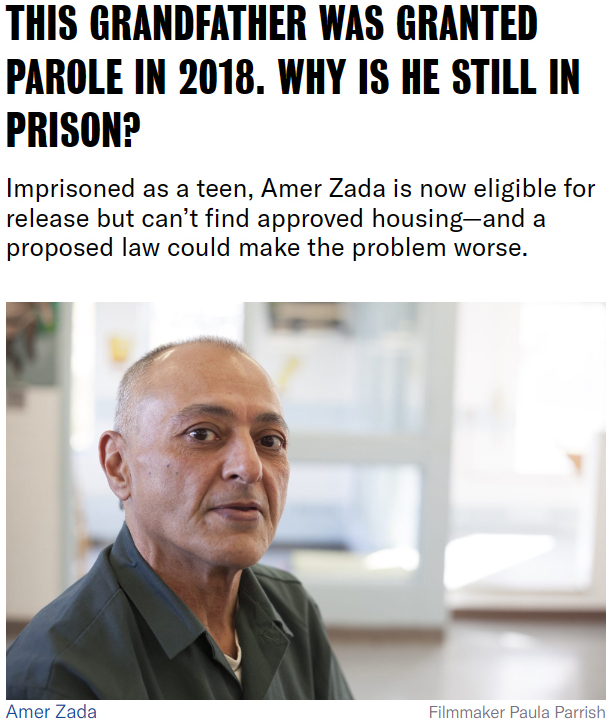
At first Zada tried to claim he was attempting to "help the girl" that he "just happened to" come across behind a dumpster.
When that did not work, Zada and his family claimed that he was being framed because he is Muslim (the family was from Jordan) and that the police and Rockland County District Attorney are conspiring to prosecute and destroy the entire Zada family - the father and three sons and a daughter - Amer was the youngest - because they were Muslims.
It is true that Rockland County prosecuted Amer's father and his two older brothers, Samir and Nazir, in multiple separate cases over the previous decade. And they were indeed all convicted in jury trials in the early 1970s, of violent assaults, drug dealing, pimping, and one of the brothers, Samir was a convicted in 1973 as a serial killer in two brutal torture murders. (His brother Samir was deported to Jordan after his parole in March 2014, even though he was a strong suspect in a third murder.) The other brother, Nazir Zeda, a paroled pimp and a drug dealer, died on the floor of a prison visiting room while on a visit to his serial killer brother Samir, after a balloon of heroin that he was smuggling to his brother up his anus, burst and killed him.
Little seventeen-year-old brother Amer Zada was the up-and-coming new baby in the violent Zada clan of pimps, drug dealers and a serial killer. They had terrorized the people of Rockland County for over a decade.
Regardless of family reputation, a jury easily convicted Zada at trial in 1980 of second-degree murder, first degree attempted sodomy and aggravated sexual abuse.
The necrophile killer was sentenced to a term of
twenty-five years to life. He served 38 years, insisting he was framed,
but filed numerous appeals, including that "Zada’s
defense counsel was ineffective for failing to raise an insanity defense"
which would entail an admission that he actually committed the murder but
was insane.
Zeda was finally paroled in 2018, promptly re-arrested for violation
of his parole, and paroled again. He is today a
Registered Class 3 Sex Offender in New York State, the most dangerous
class of sex offenders.
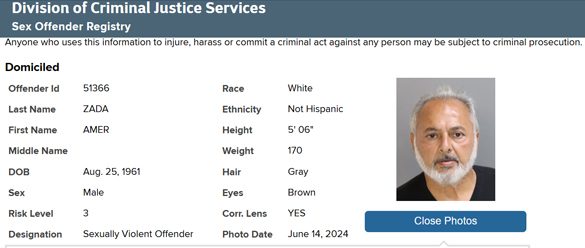
A New York City filmmaker and Innocence Project advocate for the wrongfully convicted and innocent, with nothing better to do, and very vulnerable to manipulation by the charming and charismatic grand-fatherly paroled psychopath necrophiliac killer, swallowed hook, line and sinker his absurd claims of being a victim of primitive Rockland County law enforcement 'Irish hillbilly' conspiratorial Islamaphobia. She made his claims of innocence a cause of her own.
Along the way she got Vice TV documentary deal to tell the story and document and fund her cause. (Same kind of TV deal I had with a different company to tell a story, and document and fund my cause; just like her.)
She alleged that a cabal of Nyack police and Rockland County District Attorney functionaries had knowingly conspired to frame Amer Zada at his trial back in 1980, by concealing evidence and rewarding and/or intimidating witness testimony against him. She ended up filing the dreaded (by law enforcement) FOIL (Freedom of Information Law) petitions for access to police and prosecution files, in a search for evidence of misconduct back in 1980. (See Part 8)
If true, if she is correct and if Zada was innocent, Rockland County is potentially facing a multi-million dollar money train lawsuit from Zada, who spent 38-years in prison before being paroled.
If true, the question was now, if Zada did not murder Shirley Smith in June 1979, who did? A good question.
Richard Cottingham, the Torso Serial Killer, was obviously on the list of potential candidate suspects.
Conor was doing some 'just in case' due diligence for the people of New York when he brought up the Shirley Smith murder with Cottingham in an interview.
"A GIRL OFF 9W"
Cottingham immediately denied killing Smith, but very casually, as he often does, said that in the 1960s and 1970s he had often frequented
bars and clubs in Rockland County, along Route 9W and that [by the way] he remembers
murdering a girl there, but he could not remember when precisely, or who or
where. But it was not Shirley Smith, who was an
African-American, whom would have remembered.
Cottingham stated that all he could remember was, "It was before I got married. A girl off 9W."
Conor and Salomon asked me to dig back in my files and sources, if I could identify any potential Cottingham murders in the vicinity of 9W in Rockland County around the time he was married that could be a fit.
That's how the case of Lorraine McGraw began.
Lisa Thomas Cold Case Murder 1974
The
only murder I had mapped in Rockland County that fit like a glove Cottingham's MO and signature at the time, was the 1974 murder of 15-year-old Lisa Thomas, in Nanuet, who had been attacked and
battered to death in a wooded area adjoining the nearby Nanuet Mall parking
lot in the middle of the afternoon. She frequently used it as a short cut,
and police never determined if she was on her way to the mall or back from
it.
The murder in many ways was identical to Cottingham's murder of Jackie Harp
in 1968. (See Part 4: 2017 - Closing the 1968
Jackie Harp Cold Case Murder).
Except the Lisa Thomas murder I had put on the task force list already.
Conor himself, in police parlance, "liked Cottingham for Lisa Thomas" too, independently of my own suspicions.
The Lisa Thomas murder was coming into his jurisdiction as he was soon moving from S. Nyack PD to the Rockland County District Attorney's Office as an investigator there. Conor was one of those ambitious 'contract cops' working for multiple agencies, including Homeland Security, hoping to one day land a permanent job and advancements that come with it. (Like contract adjunct professors like me.)
But Nanuet was about 5-6 miles drive from 9W, not exactly "in the vicinity" nor was Lisa Thomas's murder related to any bars or clubs on 9W.
I went back to see if I missed anything in the newspaper files.
Sure enough I ferreted out a 9W related unsolved murder case on newspapers.com that matched Cottingham's MO and signature and his forensic geography that I had not come across in my earlier searches. Adding the search term "9W" rendered a hit on the case.
The website is a valuable tool for cold case
investigators, but one very limited by text search terms one enters.
It is only as good as the search terms renders, and I did not always hit on
cases I should have. Fortunately there is a network of cold case researchers
who would hit on cases I did not and would alert me to those they thought I
should be looking at, like the mysterious anonymous
Murder, Inc.
who runs a cold case blog and is very talented in identifying forgotten cold
cases.
"THE NUDE BEAUTY"
The murder case I hit on, was reported on March 1, 1970,
a murdered woman found in South Nyack, two months before Cottingham got
married.
S. Nyack was on the opposite side of the Hudson River, north of New York City, where the Tappan Zee Bridge (Governor Mario M. Cuomo Bridge) crosses the river and connects to 9W.
Rockland County, New York, bordered on Bergen County, New Jersey, where Cottingham had told me he frequently would drive from his home in Bergen County across the state line into Rockland County because they had more liberal drinking laws and the bars stayed opened later. There was a lot of clubs and resorts and action along Route 9W.
Cottingham's Uncle Edward's house as well, a geo-forensic 'secondary anchor' (See Part 1-C: Mapping the Torso Serial Killer's Mind and Murders) was off East Saddle Road and bordered on the New Jersey-New York state line north of Montvale, where Cottingham had his "killing field", an orchard and corn field in which he murdered Nancy Vogel in 1967 and near which he left the bodies of Lorraine Kelly and Mary Ann Pryor in 1974 and where the "three dead girls in the well" were located that BCPO Chief of Detectives Robert Anzilotti and I were searching for. (See Part 2: 2010 - Solving the Nancy Vogel 1967 Cold Case Murder)
Cottingham at the time of the murder had been working in Manhattan since 1964, but was still living at home in his parents house in River Vale on eve of his upcoming marriage in May 1970. The Rockland-Bergen County state-line and the bars and clubs along 9W were definitely 'Cottingham country.'
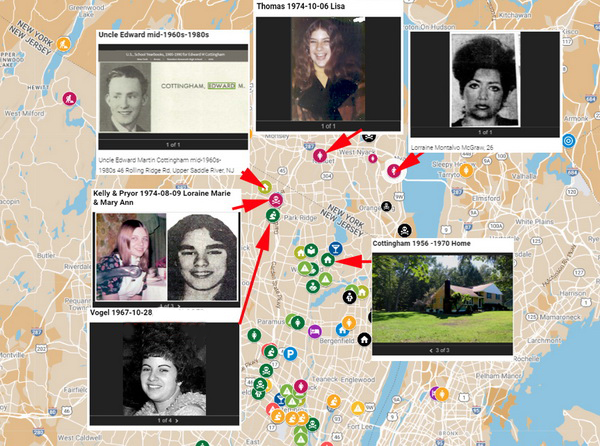
New York -
New Jersey Police Department Joint Cold Case Open Data Portal
www.nynjpd.org
The victim was found in a remote hilltop forested 'lover's lane' just outside of South Nyack, New York. For about a week after being found, nobody knew who she was.
Typical of the era, the press salaciously dubbed the unidentified woman as the "Nude Beauty."
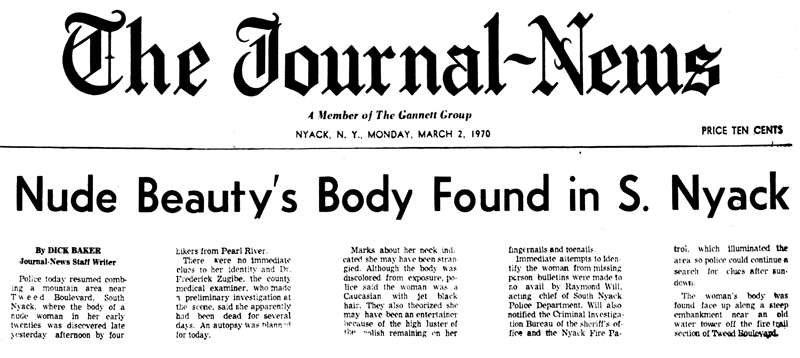
THE CRIME SCENE
Her body had been discovered on a Sunday afternoon by four teenage hikers from
Pearl River, NY, in a forest near an abandoned water tank at the end of a
small dead-end unpaved fire lane running off Tweed Boulevard, a two-lane
road weaving through the hills north west of South Nyack.


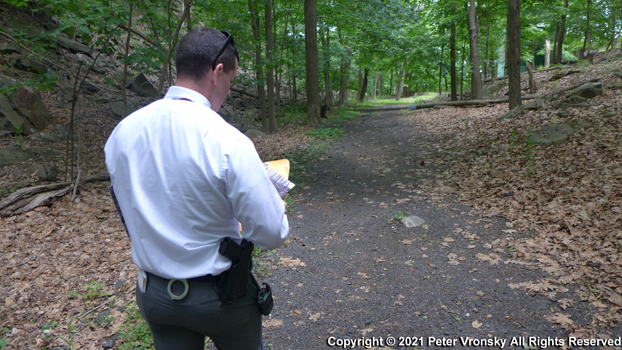
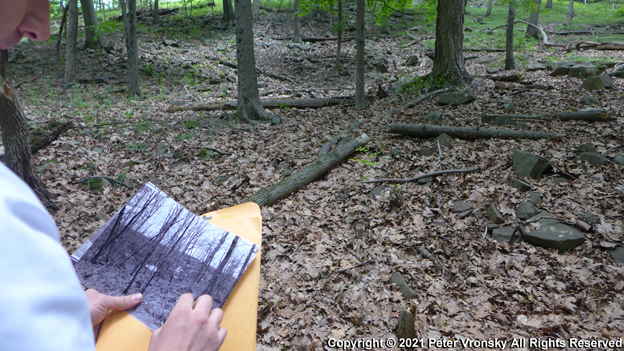
(Top Row) (left) Entry at Tweed Blvd; (right) looking back toward entry
from scene;
(Bottom Row) approaching scene from Tweed; at the scene. Photos Copyright © 2021 Peter Vronsky
The crime scene had Cottingham's MO and signature all over it.
She was completely nude, no personal belongings, no clothes or identification were found in the vicinity. She was laying on her back, face up, on a rocky tree branched slope. Her legs were elevated, draped at the knee over a log. She had been murdered by ligature strangulation. The ligature was taken away by her killer. There was a blunt instrument injury resulting in a four-inch fracture over her right ear, the weapon also missing from the crime scene.
Her body had been carried up the slope, not dragged. Her arms and limbs were slightly bent, whereas when a victim is dragged, often they are found with their arms raised straight above their heads, as the killer either drags them by the wrists or the ankles. Nor were there any major drag marks or scratches or disturbance in the foliage. She was found almost immaculately naked. Her killer must have cradled her in his arms, carrying her up the slope, like a monster.
According to the medical examiner, she had sexual intercourse recently, but there was no evidence of forcible rape. He estimated that she had been there anywhere for 28 to 48 hours, since Friday night likely. That would fix actual date of her death as February 27, or perhaps the early morning hours of February 28.
She was petit, 4-feet-11-inches, 105 pounds, dark hair and pierced ears and tattoos on her right and left upper arms, uncommon in the 1960s for a woman. She also had "small scars on both lower arms" and a 1" scar on her left arm. She had given birth at some point in her life.
The police theorized to reporters, "she may have been an entertainer because of the high lustre of the polish remaining on her fingernails and toenails."
SANPAKU EYES: "SINS AGAINST THE ORDER OF THE UNIVERSE"
Rockland District Attorney Robert Meehan stated that the unidentified woman was a "very pretty Latin
type" and "extremely beautiful."
A newspaper described her as "beauteous, apparently of Latin extraction, with almond-shaped eyes, slight features and good teeth."
There was something special about the woman's eyes; they had a hypnotic draw even in death, those "almond-shaped eyes."
She had sanpaku eyes.
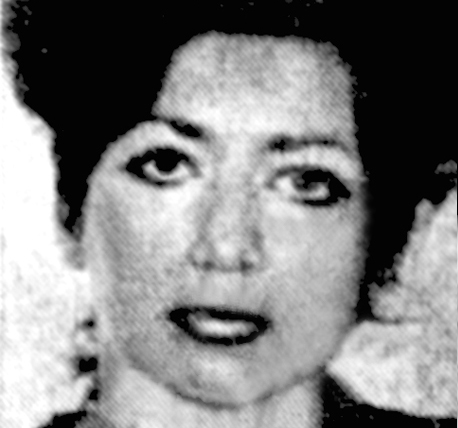
The term “sanpaku eyes” gets its name from the Japanese language. It means “three whites” and refers to the white part of the eye, the sclera, showing either above or below the iris and its pupil. In Western medicine, the condition is known as "scleral show" and can be inherited or can be the result of aging, injury or disease or caused by complications from blepharoplasty (cosmetic eyelid lift surgery).
In Japanese traditions sanpaku eyes are rooted in superstition and folk lore.
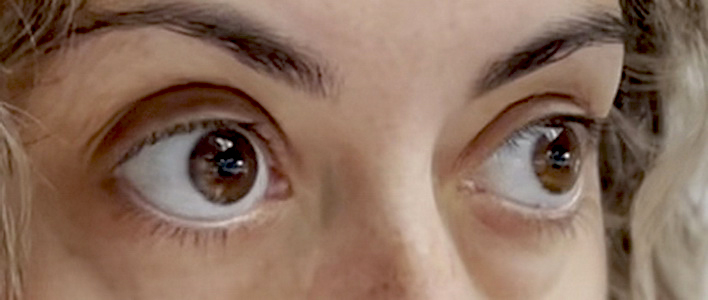
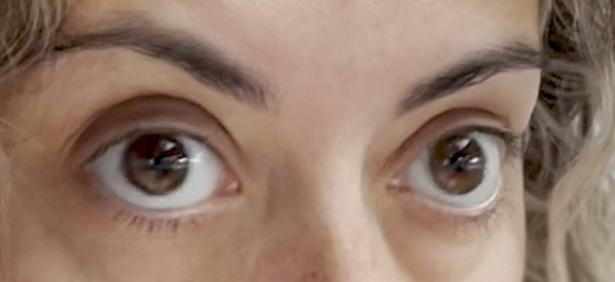
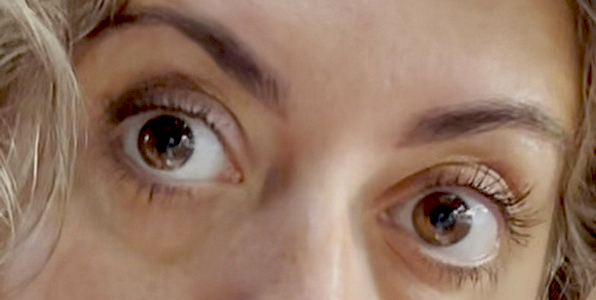
The hereditary sanpuku eyes of Lorraine
McGraws'
granddaughter.
Copyright © 2022 Peter
Vronsky All Rights Reserved
In traditional Chinese and Japanese physiognomy (face reading) when the white sclera part of the eye is visible beneath the iris, it represents physical imbalance in the body and is claimed to be present in alcoholics, drug addicts, and people who over-consume sugar or grain. When the upper sclera is visible it is said to be an indication of mental imbalance in people such as psychotics, murderers, and anyone full of rage. In either condition, it is believed that these people attract accidents and violence.
Nyoichi Sakurazawa, a Japanese practitioner of alternative medicine, wrote:
"For thousands of years, people of the Far East have been looking into each
other's eyes for signs of this dreaded condition. Any sign of sanpaku meant
that the person's entire system — physical, physiological and spiritual —
was out of balance. They had committed sins against the order of the
universe and were therefore sick, unhappy, insane, what the West has come to
call "accident prone". The condition of sanpaku is a warning, a sign from
nature, that one's life is threatened by an early and tragic end."
(Nyoiti Sakurazawa, William Dufty
translator (1965) You Are All Sanpaku,
p. 70, Citadel Press, New York.)
These were old time Japanese traditions and superstitions, but here she was dead naked on a hilltop - on superstition mountain. How did she get there?
THE HAUNTED WOODS: "TO UNDERSTAND THE ARTIST, LOOK AT HIS WORK."
When Conor and I went to walk and survey the scene of the murder in 2021, it
had not changed much since 1970, other than a locked gate at the Tweed
Boulevard entry.
The rock formations remained the same and it was easy to find the exact position where the body had been found.
I don't know whether my knowing what had transpired there triggered my imagination, but as the breeze passed through the trees I heard a pained sigh.
We walked the ground in the late spring, but the murder had occurred in the barren winter months on the last days of February, about eight weeks before Cottingham was going to marry on May 3, 1970. It might have been his last "bachelor murder" - he killed one woman every six weeks on average, give or take a few weeks here or there, from (confirmed) 1967 until May 1980, but I suspect it was from 1963 when he was a high school junior in New Jersey to 1980 when he was arrested at random.
Ground can have strange ghostly temporal qualities and dead ground can come back and haunt you the way people do.
As a historian I had surveyed crime scenes, battlefields, death camp sites, siege works, sunken mass graves and massacre ruins. I had descended with my colleague cinematographer Tony Wannaker into an execution pit from 1938 and extracted with my gloved hands jaw bones with rows of teeth and cranial fragments with executioners' bullet holes through them.
When you see and walk that kind of ground in the same light filtering through the trees leafed out the same way, you sometimes see indescribable 'things' in the arc of the light and hear 'things' through the rustle of the foliage or dig out.
When you 'un-cork' the dead in their restless falling places, things can happen. I was on a dig of the clothed remains of a woman buried for 54-years caked in mud, and when she was exposed to the air, as the mud cracked, a short micro-second waft of perfume came off her mud-encrusted baby blue cashmere sweater draping her bones and semi-mummified shoulders. It shot up like a dead fairy princess shooting star into my nostrils, just before the musty smell of dead mud caught up and she was gone. I don't know who she was but I will never forget her and always think of her when on rare occasions I catch the scent of that perfume on somebody. I make sure to never discover what brand of perfume it is; to know the perfume and start tripping out to the dead on it to the other side would be dangerous; the risk was not being able to find your way back.
The closer you come to the dead ground as it was in the time of the occurrence the closer you come to its dead. The Civil War historian Shelby Foote talked about it, how he walked the fields of Shiloh on the same day and hour his ancestors had fought and died there in April 1862, and "seeing ghostly soldiers" in the gleam of the light filtering through the treetops.
Things shimmer and shimmy in haunted woods, and the breezes murmur and moan, things snap, crack and crunch behind you, and if you pause and stop and look and listen and turn yourself inside out, they don't so much show or say things to you, but light a path to them, an almost holy sendero luminoso.
Sometimes like a thistle's burr the unquiet dead attach themselves to you and don't let go. The way this victim would. My first real cold case--one on my hands, not someone else's being written about by me.
I came back in the night, and walked the scene again in the dark on the trail through the woods the way they would have been when her killer brought her there and took her life. It was a dark and spooky and lonely place to die once the sun had set.
I wondered why she was left there up on the slope so visible and exposed, and not further down out of sight near the end of the road, closer to the abandoned water tank, where the road took a slight descent downwards into a hollow. As I pondered this question, behind me about two hundred yards back where the entry gate was on Tweed Blvd, the trees and the road began to glow with an ethereal light. The light got brighter and brighter, the trees almost almost turning a glowing white until a set of headlights broke into view and whipped past the gate, leaving behind the pitch black again.
Cottingham had told me very early on in my interviews with him, that when he "dropped off" bodies he was always careful to choose locations where he could see vehicles approaching from a long distance away. Always. When I looked down the trail at night, as cars would approach on Tweed Blvd, I realized the road and trees at the gate would get gradually brighter until the headlights and the car broke into view. He would see the light long before even the vehicle arrived.
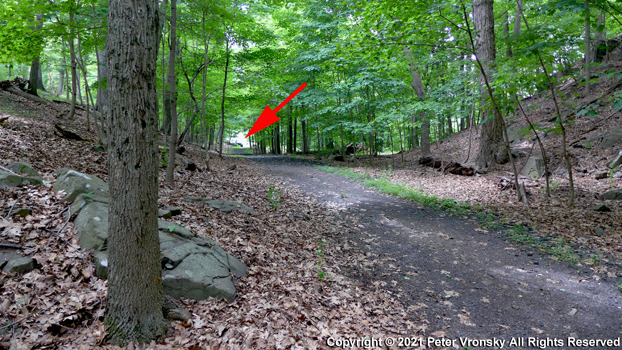

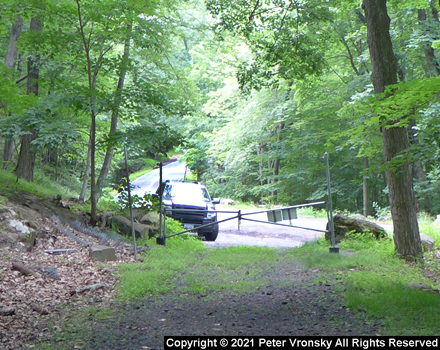
Cottingham always kept a wolf-cunning animal line of sight like this at his crime scenes. Had he gone any further down the fire lane, his view would have been obstructed in the hollow of the road.
Cottingham also said he "dropped off" his victims out in the open so they could be found quickly, "I didn't want the animals to get at them. Out of respect for them."
It took me some time before I caught on what he meant in his serial killer's
logic by "dropped off" and "respect." I
was thinking at first 'dropped off' like in "I dropped off the kids at school; I dropped
off my date at her house." He couldn't bring himself to say he 'dumped' them.
But that's what he did. And then he did not think about them further.
He said, "once it was over, I never dwelled on it."
By then, in 2021, I knew a Cottingham crime scene the way I knew the veins in my
hand.
As, the pioneering FBI "Mindhunter" profiler, John Douglas once said, "If you want to understand the artist, look at his work."
This murder was Cottingham's "work" no doubt:
victim ligature strangled but ligature taken away;
victim non-lethal head injury, intended to 'stun' them;
sexual intercourse but no sign of forcible rape;
belongings missing;
body left near a vehicle-accessible location;
line-of-sight distant view of approaching traffic;
victim left out in view where they would be quickly found
This one was his, with all his MO and signature emblazoned on it as if he signed it as the last thing he did before he left to go marry his fiancée in Queens Village on the opposite side of his New York murder map.
WHO WAS LORRAINE MONTALVO MCGRAW?
When S.Nyack PD and the Rockland County District
Attorney's Office began attempting to identify the "Nude
Beauty" with the sanpaku eyes, they had some difficulty lifting her finger prints in the first few
days, as the forest moisture had wrinkled them. Eventually the ME
managed to lift prints and they were sent to local neighboring agencies and the FBI.
This is all before computer networks and data links. Queries took days and
sometimes weeks to be processed, not the seconds that they can be done in
today.

The FBI fingerprint check came back first, with a record of a former inmate by the name of Diane Boyd who in 1965 served a year sentence in the Westfield State Farm Reformatory (Bedford Hills Corrections Facility today) in Bedford Hills, in Westchester County, upstate New York, on a possession of a controlled substance and possession of a hypodermic syringe for illegal use.
The name "Diane Boyd" was at first entered into the Rockland County Records as the name under which her body had been found and it is the last item that was punched into her police record as well, before it was locked down closed: "Diane Boyd, Prts. Recd." [Prints Received] and "DOA [Dead on Arrival] Died of Strangulation, Found 3-1-70 in Wooded Area in Nyach,[sic] NY."
But then other record inquiries began to file responses and by the end of the week it became evident that "Diane Boyd" had multiple arrests under a string of aliases: Susanne Kennelly, Deborah Ann King, Sherrie Daniels, Karen Connolly, Edith Bablove, Terry Rivers, and eventually arriving at her actual legal name, Lorraine Montalvo McGraw.
Her name was released to the media on March 7, 1970.
Lorraine Ann Montalvo, 26-years-old, was born on March 10, 1943, making her ten days short of twenty-seven when she was murdered. She was a mother of two children, a nine-year-old girl Emily "Emi"* (pseudonym) and eight-year-old boy Billy* (pseudonym) at the time of her murder.
She was not a local woman from Rockland County; she was from New York City, quite a distance from this remote hilltop lane where she came to be strangled and battered to death.
Lorraine grew up in the Queensbridge Houses public projects, in Long Island City in Queens, something that will gain further significance and scope as her cold case murder investigation and its solution will unfold.
Lorraine Montalvo was sixteen when she married Robert McGraw in 1959.
She was seventeen when she had her first child, her daughter Emi* in May 1960, followed by Billy* a year later.


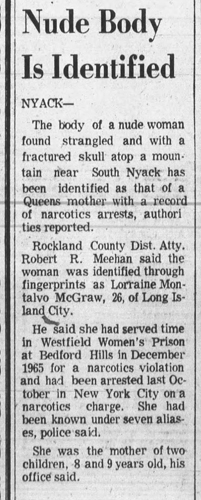
THE LIFE AND CRIMES OF LORRAINE McGRAW
In determining whether a suspected perpetrator murdered a victim, you need
to know the victim as well as the perpetrator.
As I reviewed the records on Lorrain's background and came to her criminal record, the first thing that jumped out at me was that she was twenty-two years-old when she was first charged with any crime (at least as an adult), when her kids were four and five years old. (State of New York, Executive Department, Identification and Intelligence System files, March 15, 1970, McGraw, Lorraine (Montalvo), DCI No. 11308594V.)
Lorraine had been reasonably far along in her young adult life, married, and a mother of two, when her first arrest on the record occurs on June 8, 1965, under the alias "Diane Boyd", in the NYPD 25th Precinct in the northern section East Harlem, north of E 115th Street, a predominately Puerto Rican neighborhood at the time.
It was a double charge, and serious too; a PHL §3305 (Public Health Law) violation, possession of a controlled substance; and PL §1747-E (Penal Law) charge, possession of a syringe for narcotics use. She was shooting heroin; or carrying for someone who was.
Perhaps Lorraine had a juvenile record, perhaps she had evaded being arrested, but this was her first arrest as an adult that resulted in a charge. Unusually late in her life, twenty-two years old.
Despite newspaper reports that she had "multiple" narcotics arrests, this would be the only drug arrest on her record. Nor was Lorraine's criminal record as extensive as the newspapers hinted; between her first charge in 1965 and her death in 1970, Lorraine had only eight arrests on her record, one of them a minor charge of driving without a license. Lorraine's rap sheet was meagre poor two pages only, from her first arrest to her death.
Perhaps something went wrong in her life in her twenty-second year, propelled her off her path, "triggering" Lorraine that summer and autumn of 1965 to suddenly spiral and lurch into multiple arrests, one after another, under different names and aliases. Maybe it was the heroin; maybe it was something that led her to heroin. Heroin is a powerful substance. They say, if God made anything better, he didn't tell anybody about it. They say, heroin is better than sex; it's love. Literally. Some users feel the bliss of love on heroin, pure indescribable pleasure and euphoria, and they become broken hearted in pain without it. When the time comes, they will do anything for a fix.
Lorraine's next series of arrests began three weeks later, in the NYPD 16th Precinct in midtown Manhattan.
LORRAINE AT THE "CROSSROADS OF THE WORLD"
Today the 16th Precinct is a fictional non-existing
precinct featured in the popular television series Law & Order: Special
Victims Unit and the movie Police Academy 2, but in 1965 when
Lorrain was arrested, the 16th Precinct station house was on West 47th
Street near Eighth Avenue in Midtown Manhattan, a block from Times Square,
known as "crossroads of the world." Later it would be split up between Midtown
South Precinct, and the 10th Precinct, where coincidentally Cottingham was
going to murder Deedeh Goodarzi and the unidentified girl in the Travel Inn
in 1979.
One of many coincidences that the Cottingham saga is rife with.
Lorraine was going "big time" in the 16th Precinct, in the Times Square district and on the "Deuce" or the "Forty-Deuce", the W 42nd Street 'movie theater strip' between Broadway-Seventh Avenue and Eighth Avenue, and the warren of side streets that ran behind it.
In 1965 Times Square and the Forty-Deuce were in their early stages of transformation into what would become the epicentre of New York's illicit sex industry as the peep shows, massage parlors, adult book stores, porn theaters and grind houses, were beginning to flourish in the wake of multiple US Supreme Court decisions on the definition of obscenity, freedom of speech and the definition of vagrancy under which street sex workers had been futilely arrested in New York for decades. A Supreme Court judge in 1964 when ruling on what might be the legal language for a threshold definition of obscenity, had famously said, "I know it when I see it." (Supreme Court Justice Potter Stewart, Jacobellis v. Ohio, 1964.) What he meant, was that each community has its own standard for obscenity, and they would know it when they saw it, they needed no law defining it, and of course we know that New York City had hardly any standards for it at all. Anything goes in New York.
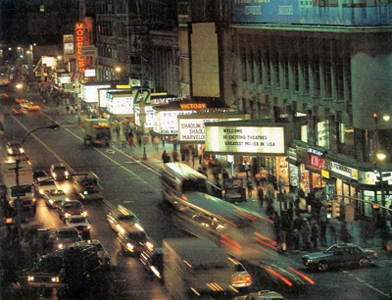
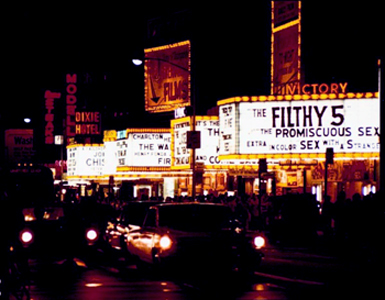
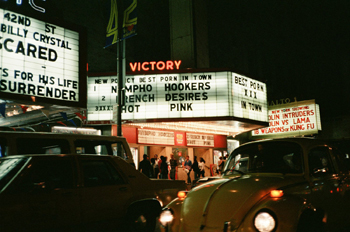
It was the beginning of a "porn and rub & tug peep show renaissance" and transformation of Times Square and the Forty-Deuce into New York's 20th century version of Victorian London's Whitechapel and Richard Cottingham was going to be its Ripper, the quintessential American Werewolf. It would be a feast for a beast.
By the 1970s, some forty-thousand sex workers would daily work
various locations in New York City with Eighth Avenue above W. 42nd
Street and the Port Authority bus terminal, the hot zone track, the Mecca
of low strolls, the
ground-zero of the pump, of street sex work. So many sex workers on
Eighth Avenue, that the NYPD had to put up parade barricades to keep
them from spilling out into the avenue and getting run over by a car.
(Claire
H. Cooney and Janet Quint,
Prostitution in New York City: Answers to Some
Questions, Publication of New York Women in Criminal
Justice in collaboration with the Prostitution Task Force: New York, 1977.)
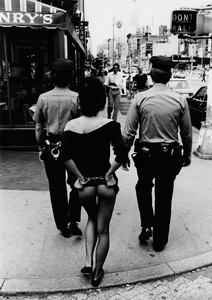

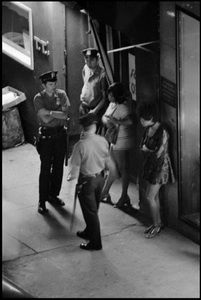
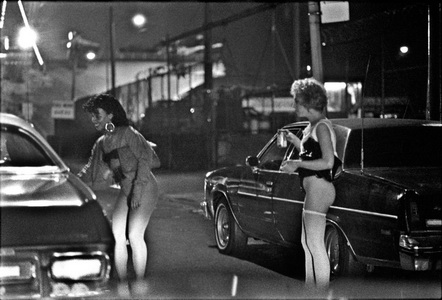
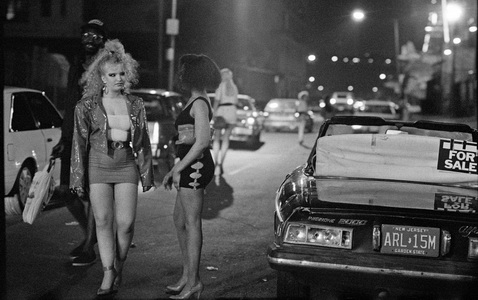
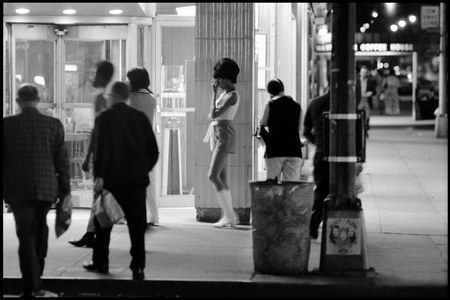
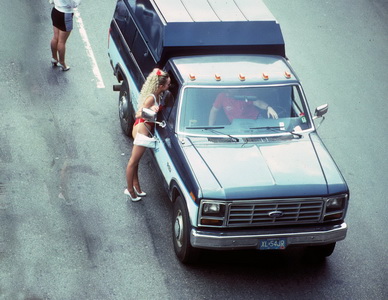
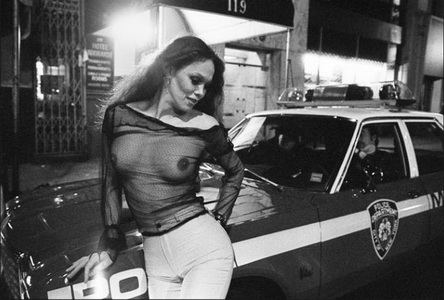
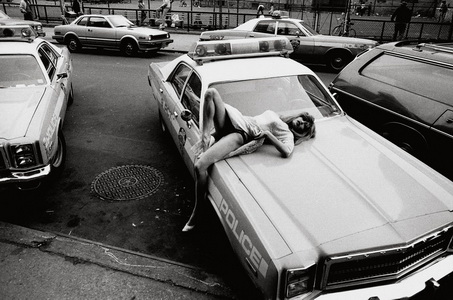
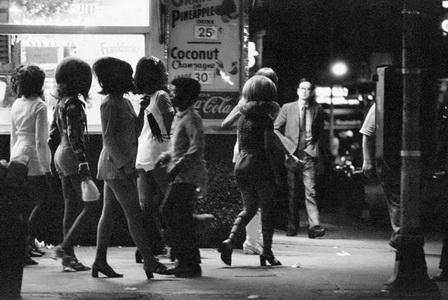
On June 30, 1965, three weeks after her first arrest on a heroin possession charge in East Harlem, Lorraine is arrested in the 16th Precinct on a minor charge as "Susan Kennelly" for the unlicensed operation of a vehicle. No big deal.
August 4, 1965, she is arrested again, this time on a CCP §887-4A (Criminal Code of Procedure) charge as "Deborah Ann King" on a prostitution offense, which at the time was rooted in New York State's vagrancy laws. (CCP, Part 6, Title VI, Of Proceedings Respecting Vagrants, paragraph §887-4 defined a vagrant as "A person who offers or offers to secure another for the purpose of prostitution, or for any other lewd or indecent act.")
No disposition for the charge is indicated on her record, which suggests this very likely was her first arrest as a sex worker, and she was ROR (Released on Own Recognizance): a one-time 'stay out of jail for free' card.
October 28, 1965, Lorraine is arrested again three months later, again in the 16th Precinct, as "Karen Connelly" this time, on a second CCP §887-4A prostitution charge and this time she is made to serve a 15 day sentence, it being her second sex work charge.
IN "THE TOWERS" AT NEEDLE PARK
The address Lorraine gave police at the time of her October 1965 arrest was
the Hotel Manhattan Towers on Broadway and W. 75th Street, one of the worst SROs (Single Residency Occupation) welfare
transient shelters in New York City. Rooms went for about $10 and up per
night for a single and $150 monthly. It was a haven for junkies and sex
workers, the site of a murder, rapes, and multiple robberies; 15 percent of all robberies in the 20th Precinct
where the hotel was located, took
place inside the Hotel Manhattan Towers.
The Towers was conveniently located three blocks away from "Needle Park", as Sherman Square and Verdi Path at the triangle of Broadway, Amsterdam and 72nd Street were known, an open air market for heroin, vividly captured in the 1971 Al Pacino movie directed by Jerry Schazberg and shot on location just a few years after Lorraine had lived near there, The Panic In Needle Park. ("God help Bobby and Helen. They are in love in Needle Park.")
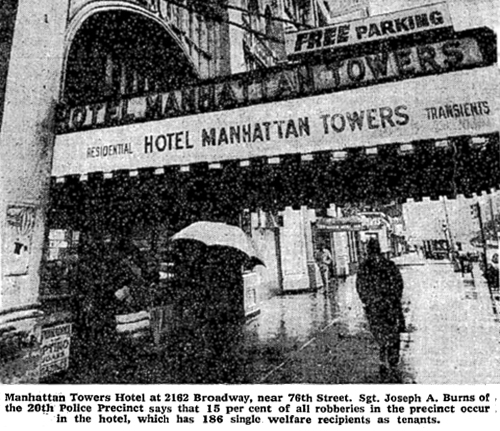

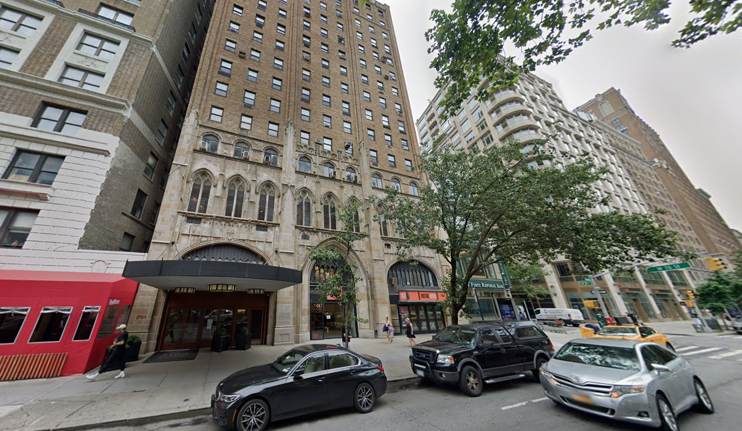
(R) Today the former Hotel Manhattan Towers is
re-branded as
The Opera Co-op where small apartments start at $1.7 million to
purchase.
Lorraine could not have brought her two children into the Towers with her even if she wanted to. It's unclear whether in 1965 she was still with her husband Robert McGraw, or who was caring for her children, but probably it was Lorraine's mother, "Cookie" Adeline Montalvo.
The Manhattan Towers was not a good place for Lorraine to be. This was an area in New York City frequented by Cottingham, who told me that he would hang out in Needle Park to watch "the floor show" as undercover cops were busting junkies. It was a game for him to spot the undercover cops. He told me enough about his ventures around Needle Park and Broadway that I would successfully connect him to another cold case murder linked to the Manhattan Towers Hotel.
HOT DOGS AND HOOKERS: THE MURDER OF MARIA EMIRITA ROSADO NIEVES
Across from Needle Park, on the
south-west corner of Amsterdam and 72nd Street intersecting with Broadway,
was Gray's Papaya Hut that both Cottingham and I at separate times had patronized in the
1970s. It had some of the best hot dogs for the money and Pina Colada
juice out of those stainless steel barrels which Cottingham and I both reminisced about.
Cottingham had put in a lot of time in that neighborhood, especially in
the later 1970s when the infamous Plato's Retreat sex club opened in the
basement of the landmark Ansonia Hotel, two blocks from the Manhattan
Towers. Who knows,
maybe in 1975-1980 I even bought a hot dog in Gray's when he was in there,
without knowing it. It is still
in business today, last time I looked.
See: Part 1-A: Building a Rapport with the Torso Serial Killer)
These two old men reminiscences of ours about hot dogs and hookers, led me to identify a cold case murder victim that in 2022 which Jennifer and I assisted in closing in Nassau County: the 1973 murder of Maria Emerita Rosando Nieves, a Puerto Rican woman who was found on Jones Beach, in Long Island. Nieves was strangled, and found bundled in a plastic bag wrapped in a blanket with its ends tied together. Her wrists bound together with a "light cord" just like Nancy Vogel in 1967 but behind her knees. See: Part 2: 2010 - Solving the Nancy Vogel 1967 Cold Case)
Nieves was living in the Hotel Manhattan Towers on the day of her murder in December 1973 and in 2020, when I identified the Nieves case, that was the red flag that made me start suspecting Cottingham in her murder. I wasn't wrong. He confessed to her murder and on December 5, 2022 it was one of the five cold cases that Nassau County closed.
The murder of Nieves would lead me in August 2024 to my first active
Cottingham murder investigation outside of the states of New York and New
Jersey, to the 1975 murder in East Haven, Connecticut, of Patricia Meleady
Newsom, whose body was found wrapped in a similar way. At the time,
East Haven PD could not identify her. Her fingerprints were not on the
record for any previous arrests. Her younger sister Maryann Collette
for 48-years wondered what happened to her sister after she disappeared in
1975 while attending a boarding school either in New York State's Rockland
County or Bergen County in New Jersey. In 2023 she submitted her DNA
to GEDmatch. It matched the DNA sampled from the unidentified girl
found in East Haven. Maryann became aware that Cottingham lived and
frequented locations where her sister might have been sent to boarding
school. Like previous victim family she wrote to Cottingham and she
and East Haven PD reached out to me whether Cottingham was active in
Connecticut in the 1970s. He was, I confirmed, a suspect in at least
one murder there, and definitely passed through East Haven on at least one
occasion. The Newsom crime scene, was consistent with Cottingham's signature
and MO. At this writing it's an open case with my facilitation of
interviews with Cottingham.
That how it works sometimes - from an address in Lorraine's criminal record,
to a confirmed victim ten years later found on Jones Beach in Long Island,
to a third victim found in Connecticut, dead girls gathered and strung back
together like scattered pearls from a broken necklace.

It could have been just as easily Lorraine in 1965, who had been found as far away from New York City in Rockland County in 1970, as Nieves was found in the opposite direction in Nassau County in 1973, or Newsom in another state, Connecticut. That was Cottingham. That was his modus operandi; his signature; his forensic geography.
His murdered women were the geographic polar cap and equator of his appetites, women like Maria Emerita Rosando Nieves and Lorraine Montalvo McGraw and Deedeh Goodarzi. Lorraine was half Italian on her mother's side, half Puerto Rican on her father's, Nieves was full Puerto Rican, and Jennifer's mom, the exotic Deedeh Goodarzi, was of Persian Bakhtiari blood, a tribal sub-ethnicity in Iran. Cottingham was a gourmet world traveler of almond shaped eyes and killing them.
LORRAINE IN PRISON: THE FUGAZI LOSER LUCK "CURSE OF THE McGRAWS"
1965 was not a good year for Lorraine.
Just before Christmas in December 1965 Lorraine was sentenced on the "Diane Boyd" drug charges from her first arrest in East Harlem back in June. There was no leniency for her on her first and only drug offense on her record. She was sentenced to a term of 18 months in the Westfield State Farm Reformatory for Women (Bedford Hills Correctional Facility today), a minimum-and-medium-security facility for women in Bedford Hills, in upstate New York, in Westchester County.
The grim fortress-like prison for female inmates was originally opened in 1901 and was a more severe place than the term "reformatory" suggests; it had a death row for women condemned to the electric chair (although New York State had not executed anyone since 1963 and the last woman put to death by New York State was serial killer Martha Beck "Honeymoon Killer" in 1951. (Ethel Rosenberg was the last woman executed in New York in 1953, but by the federal government, for espionage. Her husband Julius was executed minutes later, in the same chair. They were the last Americans put to death for espionage, and the first executed for spying for an adversary (Russia) with which the U.S. was not a war with at the time.
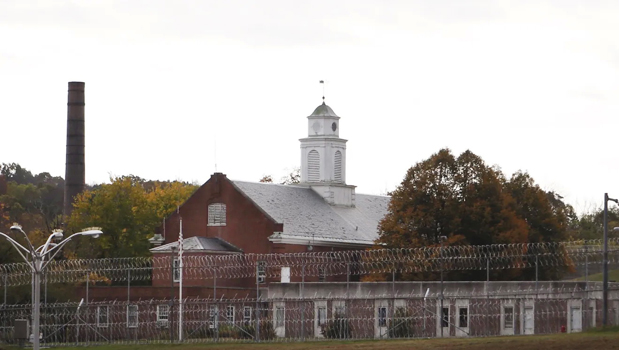
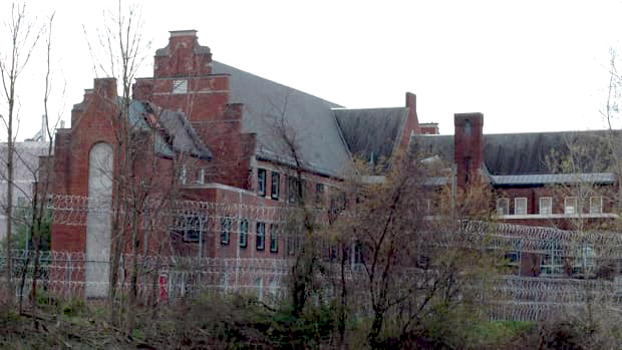
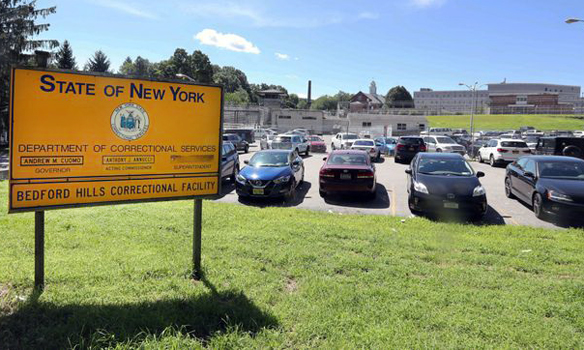
The all female prison when first established, did have a family-centered reform
program, encouraging incarcerated mothers to remain in contact with
their children. There was a even a prison nursery for infants born to
pregnant inmates.
But by the mid-1960s when Lorraine arrived there,
the nursery and the children's visiting area,
had become dilapidated and program largely abandoned.
In the 1970s a Catholic nun volunteer, who counselled inmates, Sister Elaine Roulet, would revitalize the family programs and the nursery. Since then new mothers incarcerated at Bedford Hills are separated from the general population and can participate in the Infant Development Center. Children could stay in the nursery until they are 12 months old, with the possibility of extension up to 18 months so that the mother can be released with her child. It is the longest operating prison nursery in the USA and to this day serves as a model for other similar prison programs in the United States.
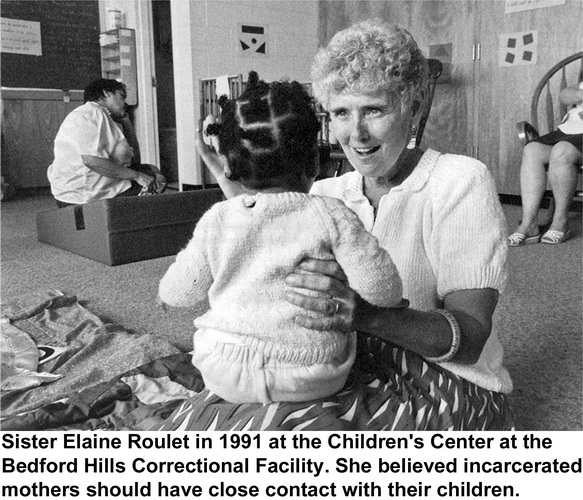
Sister Roulet also organized buses from New York City for older children to visit their mothers in prison and summer "camps" where children stayed with nearby host families so they could visit their mother daily during weekends and summer holidays. She founded a network of ten Providence Houses in New York to shelter released mothers and their children to insure they do not end up in SROs like the Manhattan Towers, or become homeless or fall back on crime to survive. (By the late 1970s, the SROs were housing women with their children. I remember seeing little kids playing in broken glass and used condemns on the sidewalks in front of some of the SROs around the Forty-Deuce and Times Square, while their moms were turning tricks in their room; places like the Hotel Carter and the Times Square Hotel.) But none of this good work that Sister Roulet was going to do, would be there for Lorraine who was incarcerated there in 1965-1966, before Sister Roulet arrived on the scene.
Lorraine had been cursed with what appears to be a bloodline of bad-timed loser luck that shouldn't have been - the "curse of the McGraws."
Lorraine appears to have stayed straight
and clean as an adolescent and teenager, the most vulnerable years,
apparently doing all the things that Church, State and family had encouraged
her to do.
She worked, she got married, she had children. And then after all
that, at the late mature age of twenty-two, she suddenly ups and goes wild.
It shouldn't have been that way. She was good all those
years and did all the right things.
And now her loser luck brought her to prison, but even there, Lorraine's
luck is again mistimed, compounded, when she missed by just a few years an era
with
an opportunity that being incarcerated at Bedford Hills could have
and should have given her to
re-connect with her two children, had she only been arrested or born just a few years later.
A could've should've fugazi.
Instead, Lorraine served a hard and lonely year in prison and perhaps it was then that her marriage to Robert McGraw had come apart, if it hadn't previously. The curse of the McGraws had no upside to it; there was no silver lining; there was nothing but lots of luck, and all of it always bad, it always ended bad, and especially so when it shouldn't have been. Not after doing everything they told her to do.
LORRAINE ON PAROLE
On December 16, 1966 Lorraine
was paroled and it does not look like she returned to Queens or to her
children, or if she did it did not last long.
On parole in throughout 1967, Lorraine perhaps tried to pull her life together, she listed her occupation in that period as a typist.
August 31, 1967, 9 months after her release from Westfield, she was arrested again in the 16th Precinct in midtown Manhattan, again on a CCP §887-4A prostitution charge, under a new alias, "Edith Bablove." Now that for once was not like the luck of the McGraws! Lorraine got a break. On September 1, the next day, a new more severe prostitution law was coming into force, PL§230.00 (Penal Law), and the charge was dropped in the midnight hour confusion.
In that arrest, Lorraine gave police her occupation as "typist" and the address of her residence as 67 W. 46th Street, which today is a massive new glass and aluminum office building, but at one time was either an apartment house or later a transient hotel, before being demolished.
For a year after that one lucky-break arrest, either Lorraine was keeping straight, or maybe she really was working as a typist, or she was successfully evading further arrests, but from September 1967 to September 1968 is a missing year for Lorraine in my story here; I have no idea where she was or what or how she was doing.
September 13, 1968 Lorraine reappears on the record. She is arrested in different precinct, the 20th Precinct, on the Upper West side under the name of "Terry Rivers."
The charge was the new one: a PL §230.00 (Penal Law) prostitution offense, which in 1967 had replaced the old CCP §887-4A vagrancy laws that were more difficult to enforce. Lorraine was arrested under the new more strict laws on sex work. Today PL §230.00 remains the current law defining prostitution in New York State as a Class B Misdemeanor, however, New York City as of 2021 is not enforcing the law and decriminalization is being contemplated.
Lorrain's charge sheet, however shows no disposition on that arrest. Probably because of what happened next.
LORRAINE UNHINGED HOLLERING WILD FROM THE CENTRE TO THE MADHOUSE
On October 16, 1968 something went terribly wrong for Lorraine.
The only thing preserved on her record for that day, is Lorraine's claim that she is a housewife, and the address she was living at when police made contact with her. 249 W. 80th Street.
Today that address is to a side door entry to a building on the corner of Broadway and W 80th Street in which the famous upscale Zabar's gourmet food emporium is located. Zabar's was there on the ground floor since 1934 as an ordinary neighborhood grocery store, but after the Upper West side became gentrified in the 1980s-1990s, Zabar's became the battleground of the Brie cheese and caviar wars for the conspicuously wealthy who were super-gentrifying the already gentrified Upper West Side.
But in 1968, 249 W. 80th Street around the corner was actually the entry into another notorious SRO, the Centre Hotel, on the floors above Zabar's.
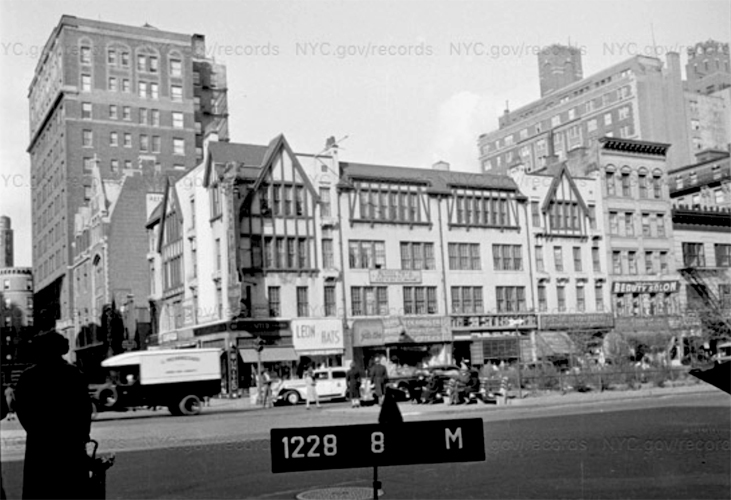

The Centre Hotel 249 W. 80th Street, then and now.
If the Hotel Manhattan Towers near Needle Park was a junkie haven, the Centre was the end of the road, a decrepit flophouse for broken-down female derelicts who had no place left to go. It was like an uptown version of a Bowery chicken-wire ceiling flea bag doss-house. The place was too disgusting for prostitution, no client would step inside.
I found a set of photographs shot inside the Centre Hotel by inspectors from HPD (Housing Preservation and Development Department), in 1966, just two years before Lorraine moved in there. The premises around the time when Lorraine was living there in 1968 looked like something out another century, reminiscent of the 1890 Jacob Riis photos of destitution and degradation in the slums of New York, How the Other Half Lives, not the mid-1960s.
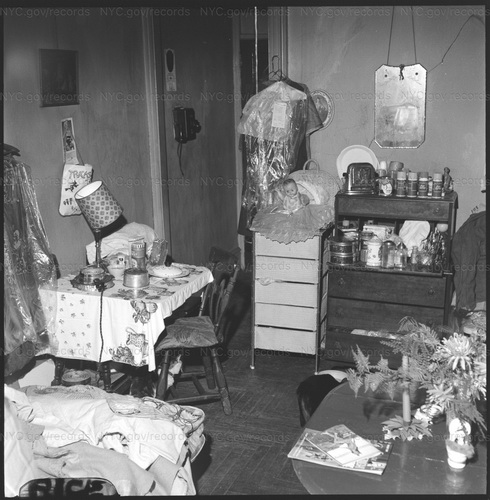
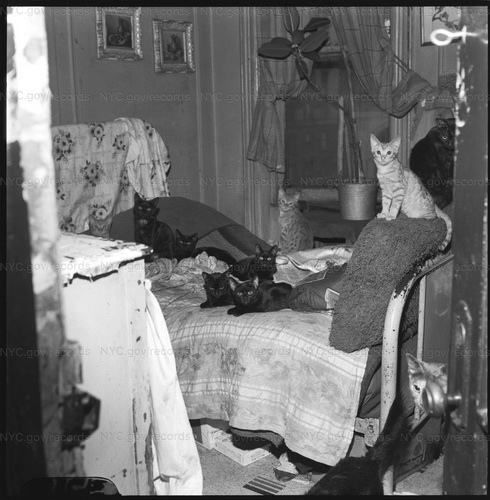
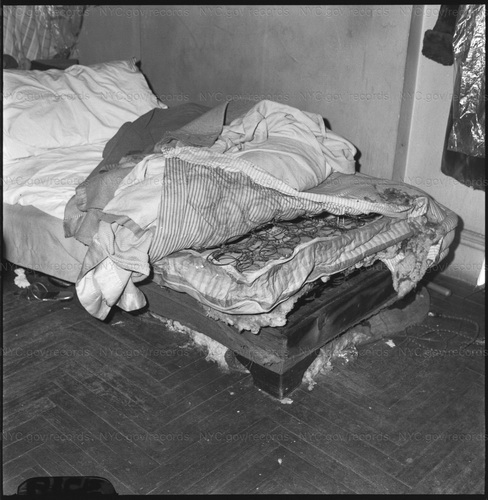
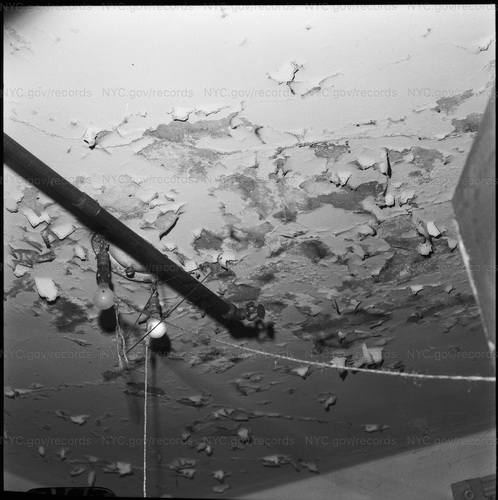
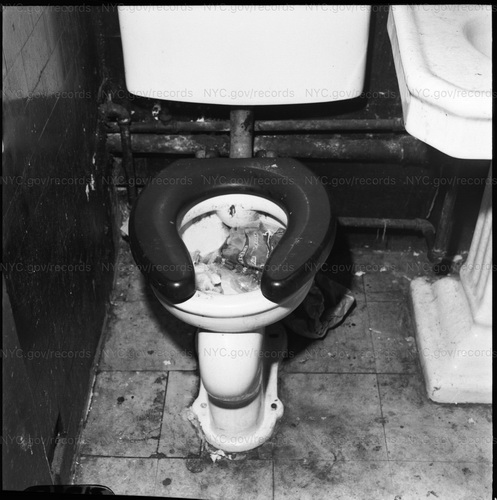
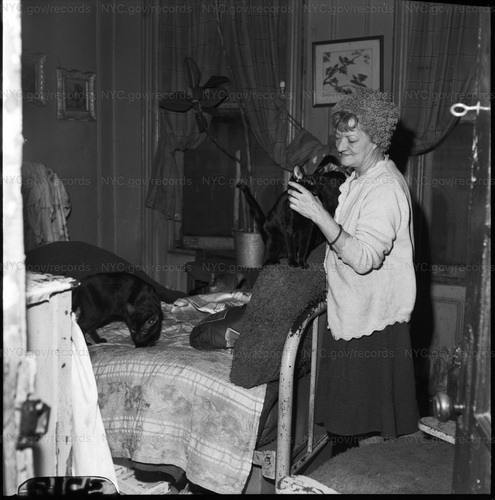
New York City Housing Preservation and Development
Department (HPD) inspector's photos inside the Centre Hotel in 1966.
(NYC Department of
Records & Information Services, Municipal Archives.)
Lorraine was not well, desperate, and perhaps something broke in her that day, perhaps Lorraine had a meltdown, became unhinged, was unmanageable and hollering wild at the hotel staff or at other tenants, and police were eventually called to the Centre Hotel that October 16. Or maybe it happened elsewhere in New York City on October 16 and she had just given that address when police took her into custody. The contact file did not survive in the NYPD archives.
I can only speculate and surmise what the triggering incident entailed, but the next day, on October 17, 1968, still under the name of "Terry Rivers", Lorraine was "certified" on MHL Section §208.4(a) (Mental Hygiene Law) for an "involuntarily admission" into a state mental hospital.

October 17, 1968 " Lorraine McGraw, aka. Terry Rivers "Certified Section 208.4 (a) Mental Hygiene Law (MHL)"
From: State
of New York, Executive Department, Identification and Intelligence System
files,
March 15, 1970, McGraw, Lorraine (Montalvo) DCI No. 11308594V
A "certified Section 208.4 (a) involuntary admission" was a sanitized term used by New York State in its public mental health laws for "forced commitment." New York state replaced the term "commitment" in 1933 to a more 'friendly' medical sounding "certified involuntary admission." (Vincent Joseph Guarrera, The Definition of Mental Illness, The Provisions for Care and Treatment of the Mentally Ill and the Procedures for Their Commitment and Discharge, Masters Thesis, Fordham University, 1968.)
To be 'admitted' under the involuntary class, a person had to have "a mental illness for which care and treatment in a hospital is essential to such person's welfare and whose judgment is so impaired that he is unable to understand the need for such care and treatment." Being "a danger to others" was also a criteria. (Marvin A. Stone, "The Right of the Psychiatric Patient to Refuse Treatment," Journal of Psychiatry and Law no. 4 (Winter 1976): 515-534)
Lorraine was forcibly committed under a new procedure in the Mental Hygiene Law updated in 1967.
The curse of the McGraws. Bad timing with a short punch-drunk temper and a
loud mouth to go with it.
Prior to a series of reforms to the law in 1965-1967, Lorraine could not have
been sent to a mental hospital without getting a court hearing in front of a judge
first, and probably would have calmed down in time and taken control of
herself to persuade the judge she was just fine.
Not with the new changes in 1967. It was
sufficient for two physicians (they did not have to be psychiatrists) to
sign off on a commitment, at the request of a family member, a spouse, or a state
agency (like the police) or social service (like welfare or a housing
authority), to issue a so-called
"two-physician certification of involuntary admission." Any two
physicians would do - and by law they had to be physicians who
were not treating Lorraine. (To keep it objective, in theory.)
There was no judge, no court, no stenographer, no cross-examination, no
appeal, no defence, no habeas corpus, no rights other than a
twisted notion that a mentally ill person had the right to treatment;
even if it had to be forced upon them for their own good without their
consent.
A person certified Section 208.4 could be held locked up in a psychiatric ward for 60 days under "doctors orders."
After sixty days, if the hospital wanted to hold her longer, the facility would need to get a court order to extend Lorraine's involuntary committal unless she had been "converted" to a voluntary patient status; hopefully 'persuaded' to 'convert' in the 60-days of forced confinement. That was the strategy behind the sixty-day confinement periods.
(A "single physician certification" in case of extra urgent need was available too, but it had to be converted into a "two physician certification" within 15 days of committal.)
The idea in the 1960s behind excluding judges and courts, was that it was 'anti-therapeutic' to expose a mentally ill patient to a judicial adversarial procedure, and best just 'medicalize' the process without a judge and court. The cops loved it.
The result was, as one MD editorialized in Psychiatric Quarterly:
"The biggest innovation hailed by some as a milestone in the treatment of the
mentally ill was the substitution of medical for legal action at the initial
stage of hospitalization. But, in contrast to past procedure, of 100 recent
serial admissions at one New York state hospital 35 patients were brought in
by police officers. And the need for hospitalization is "certified" often by
a resident with one month's experience in psychiatry.
"Thus does the current law seem to equate hospitalization
for mental illness with imprisonment for crime. Medical treatment in the
hospital is likened to deprivation of civil rights and liberty. It is, in
effect, punishment for falling sick and therefore should be handled like
punishment for crime.
"Misbehavior has become the only issue. If misbehavior
does not get you into jail, it gets you into the mental institution. And so
it appears to some that the hospital must operate like a jail...."
(Newton Bigelow, M.D. Editor "Mental Hygiene
Law, 1967", Psychiatric Quarterly, 10/1967, Volume 41, Issue 4)
The new Mental Hygiene Law became a tool for police to take misbehaving "trouble-makers" - people who "mouthed off" to police, were disrespectful, or disorderly and disruptive to business - but without actually committing any crime, to be taken off the street and locked up in a mental hospital for sixty days; "That will teach them a lesson." It was the equivalent to giving a "repeat offender" who the police could not get sufficient evidence against to charge, an old school 'trimming' in the back room of the precinct house; a mental beating, so to speak.
LORRAINE CAGED BY THE BLUE AND WHITE
So the cops just handcuffed and caged Lorraine and
the next day transported her to a
mental hospital and dumped her there for the duty physician and whatever
cooperative colleague he could round-up that day to certify her. Simple as that.
No judge heard, sentenced or ordered Lorraine for committal into a madhouse. Cops decided to have Lorraine administratively 'certified' to be 'put away' with just a sweep of the state's arbitrarily powerful social-control broom, have her swept under the rug like a bug for the 'good of society' with the excuse that it was 'for her own good.' It's always for ones 'own good' that the do-gooders fuck over people to their death.
Under the new 1967 law, the courts now had a new function. Rather than being the venue of a patient's committal, the court became supposedly the guardian of a psychiatric patient's rights.... by doing nothing. While Lorraine could not be held for longer than sixty-days, without a court order, and should she be "cured" before the sixty-days expired, the facility was required to release her early, yet she had to assert herself to claim the rights she had to regain her freedom. It wasn't going to come early to her.
Lorraine had the right to demand a hearing before a court within five days of her committal and she was supposed to have received written notice of her rights upon her arrival at the facility. But the onus was on her to understand she had that right and to take positive action within the five days, assuming she had her shit together. All those rights that involuntarily committed patients had, fell between the cracks of bureaucratic malaise, and people in a state of shock of being forcibly dragged into a madhouse and passively 'giving up' and not doing anything was the norm.
Even today you do not have to be insane, not to understand your rights, or hesitate to act on them in the face of authority. Most people don't.
Especially in the face of the blue and white authority, the NYPD and the physicians.
For more on the evolution of the
New York State Mental Hygiene Law "reforms" under which Lorraine
McGraw was
arbitrarily committed, see:
~ Joyce Daryl Chaikin,
"Commitment by Fiat: New York's New Mental Hygiene Law," Columbia
Journal of Law and Social Problems 1 (1965): 113-124; ~ Vincent
Joseph Guarrera, The Definition of Mental Illness, The Provisions
for Care and Treatment of the Mentally Ill and the Procedures for Their
Commitment and Discharge, Masters Thesis, Fordham University, 1968;
~ Mary Ann Priore Tague, Psychiatric Aftercare: A Study of the 1965
Changes in the Admission Laws of the New York State Department of Mental
Hygiene as They Affect Treatment at the Queens Aftercare Clinic, April
1966-December 1966, Masters Thesis, Fordham University, 1967; ~
Gene L. Jameson, "Insane Persons-New York Statute Replaces Judicial
Certification of Involuntary Mental Patients With a System of Medically
Determined Commitments N.Y. Mental Hygiene Law §§ 72-74 (Supp. 1964)",
Texas Law Review 43, no. 4 (March 1965): 596-604; ~ Newton
Bigelow, M.D. Editor "Mental Hygiene Law, 1967", Psychiatric
Quarterly, 10/1967, Volume 41, Issue 4; ~ Joyce Daryl Chaikin,
"Commitment by Fiat: New York's New Mental Hygiene Law," Columbia
Journal of Law and Social Problems 1 (1965): 113-124; ~ Marvin A.
Stone, "The Right of the Psychiatric Patient to Refuse Treatment,"
Journal of Psychiatry and Law no. 4 (Winter 1976): 515-534.
"REHAB" HORROR HOUSE: MATTEAWAN
Lorraine was forcibly committed (or "involuntarily
admitted" in bureau-speak) to the "Rehab Center" inside
the Dickensian-like Matteawan State Hospital for the Criminally Insane,
originally opened in 1892 and part of the Fishkill Correctional Facility in upstate
Dutchess County, in Beacon, New York.
Some of the most notorious Hannibal Lector-Michael Myers type offenders, too crazy to stand trial or be incarcerated with "normal" serial killer psychopaths and mass killers, were ordered by New York Courts to be confined at Matteawan.

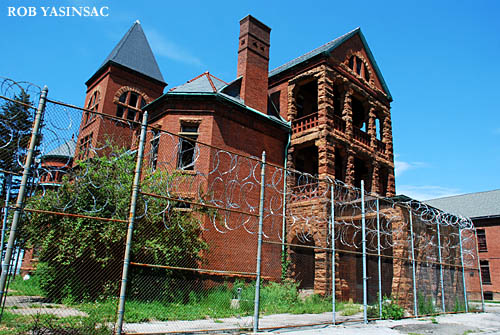
Courtesy of Rob Yasinsac at Hudson Valley Ruins
The so-called "Rehab Center" at Matteawan was not the plush Dr. Drew Celebrity Rehab from the TV show.
It was more like a Dr. Frankenstein 1960s American pulp noir torture chamber rehab with dungeons, electric shocks and mind bending drug injections and experimental brain surgery lobotomies, with Dr. Joe Mengele to assist.
A New York Times 1975 article would describe Matteawan as a "horror house". (Alfonso A. Narvaez, "Change is Urged for Matteawan," New York Times, Aug. 17, 1975, p.25.)
Electric and insulin shock treatments were used extensively, the same Sodium Pentothal "truth serum" injections that the teenage suspects in the Jackie Harp murder were getting injected with, (see Part 4: 2017 - Closing the 1968 Jackie Harp Cold Case Murder) along with hypnosis and gauntlet "group therapy" and lobotomies where cross-eyed surgeons with alcoholic trembling hands and dirty fingernails, would cut and hack synapse connections between the frontal lobe and other parts of a "misbehaving" patient's brain, permanently altering their personality to that of docile compliant zombie. These were surgeons recruited from the bottom of the medical barrel, for what neurosurgeon other than veterinary one, or a desperate failed one, would go to work in a State facility like Matteawan for the meagre state pay.
Dr. Newton Bigelow wrote
Inevitably, hospital psychiatrists have reacted to this debasement of role.
Morale is very low; as this was written there were 480 vacancies for doctors
in the New York State Department of Mental Hygiene.
(Newton Bigelow, M.D. Editor "Mental Hygiene
Law, 1967", Psychiatric Quarterly, 10/1967, Volume 41, Issue 4)
At issue was not only the psychological and physical torture and abuse of patients and inmates at Matteawan, but New York State's policy of involuntary forcible commitment of inconvenient 'ordinary' citizens under MHL Section §208.4 - like Lorraine, and the way she was packed away in October 1968 without a trial or a conviction on any offense or a court order. (New York in the late 1980s, attempted to routinely "certify" the homeless for involuntary confinement in state mental hospitals, but the courts overturned the attempt. See the case of Joyce Patricia Brown also known as Billie Boggs.)
Lorraine must have been just raging and raising a fuss and yelling that day in October when the NYPD was called to respond wherever it was she was making a scene. But she was not raising enough of a fuss to charge her with anything. She wasn't committing any violent act for which she could be arrested. So the police - probably at someone's complaint, simply transported her to Matteawan for "her own safety" and she was rubber stamped and locked up in a bedlam on an involuntary psychiatric admission.
The laws were soon afterwards reformed again and Matteawan was
finally shut down permanently and put out of its misery in 1977. Too
late to be of any help to Lorraine.
Had Lorraine got there a year earlier, or kept it together for few years more, that involuntary
commitment could not have been used against her the way it was.
The curse of the McGraws. Bad timing. Loser luck. She just couldn't win, even though she should have, over and over.
LORRAINE COMES HOME TO MOM IN QUEENSBRIDGE
The records are unclear when exactly Lorraine McGraw was released from
"rehab" at Matteawan or what kind of "therapy" she endured there, but
under New York's Mental Hygiene Law she
could not have been held longer than sixty-days on an involuntary
commitment. Unless she 'converted' to voluntary status, or there was a
review to re-certify her, she would have been released by December 17, 1968,
at least.
Lorraine had about fifteen months left to live.
Lorraine must have been beaten down and maybe scared straight after being held in Matteawan, even though she served a year in prison prior. Being thrown into a mental house with no trial could have been a wake-up call for her.
Now Lorraine came home to live with her mother Adeline "Cookie" Montalvo in 1969, to join her two children who were schoolchildren by now, aged 7 and 8, in the same apartment house on 10th Street in the Queensbridge Houses Projects in Long Island City, Queens, where Lorraine had been raised.
It's not for me here to speculate or guess on what Lorraine's relationship
with her mother was like. I imagine and guess that her marriage at the tender age of
sixteen was maybe a quick way out of the Queensbridge Houses, or perhaps
away from the typical suffocating tensions that often arise between any
teenage daughter and her mother living in close quarters with each other.
Or I might guess, (as I do not know in what month she
married) Lorraine married in 1959, because she found out she was
expecting a child, and her family on her mother and father's side, were a Catholic
traditional Italian-Puerto Rican, and 1959-1960 was an old-school world, and being a single mother was
not at all socially acceptable anywhere in that era. I don't know anything
about Lorraine's husband Robert McGraw - there are so many Robert McGraws in
New York on the public record.
Now Lorraine at age 25-26 was returning home to live with her
61-year old mother. It could have been perceived by Lorraine either as a
crushing defeat to her ambitions and independence, or as a welcomed refuge,
shelter and an oasis from the stormy troubled life that finally had put her
into a madhouse, or both.
Lorraine's mother, Adeline ("Della" & "Cookie") Montalvo (née Saintangelo) was born in 1908 and was of Italian ancestry, from Potenza in deep south Basilicata region of Italy, just north of Calabria, at the "toe" of Italy. Adeline married Paul (Pablo) Antonio "St. John" (Syngin) Montalvo on February 15, 1931. Paul was born in Cabo Rojo, Puerto Rico, and worked nearby at the Brite Corrugated Box Company on 21st Street. Both according to 1920 census reports had lived in Long Island City and probably met there.
Lorraine, was born in March 10, 1943. She was the youngest of the three daughters: her eldest sister Maria* (a pseudonym) was nine years older than her, and Giovanna "Gia"* (a pseudonym) was four years older.
Adeline gave birth to Lorraine, late in her life; she was thirty-five years old at the time. Lorraine was the "baby" in the family of five.
I was able to confirm from Paul's World War Two draft card, that the Montalvo family lived at the same address since at least 1940, crowded into a an apartment on 10th Street, in the Queensbridge Houses projects.

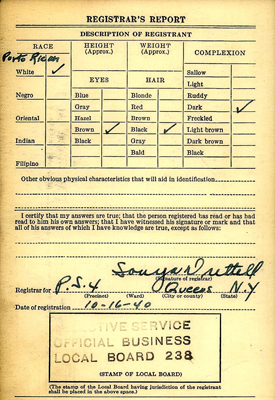
But by 1950, the US Government Census report, no longer listed Paul as living there, and Adeline gave her marital status as "separated."
She was raising the three Montalvo girls on her own now, Maria* 18, Gia* 10, and Lorraine 7. Somewhere between 1943 and 1950 Adeline's marriage to Paul came to an end and he left. He would die in March 1969 a year before his daughter Lorraine's murder.
By the time Lorraine moved back home in December 1968 or early 1969, her two older sisters both had long ago married and left. Lorraine's two children might have been in the care of "Grandma Cookie" Adline for some time now, perhaps as long as five years, since Lorraine's first arrests in 1965 maybe. Lorraine's son Billy* and daughter Emi* were schoolchildren by now, aged 8 and 9. Adeline had been probably raising and mothering and grand-mothering the two children.
"THE BRIDGE"
Queensbridge Houses Projects - known as "QB" or "The Bridge" - were built by the New York City Housing Authority (NYCHA) in
1938 and opened in 1939 and remain to this day the largest public housing
project in North America.
There are 96 six-story buildings and 3,142 units accommodating approximately 7,000 people. The apartments are notoriously tiny even by New York City standards and its elevators when it was first built only stopped on the 1st, 3rd and 5th floors; all in an effort to reduce cost. Today, the elevators still skip the 6th floor.
Like most state-sponsored Utopian dreams, Queensbridge would later become a dystopian nightmare. But in their beginning, during the FDR Roosevelt "New Deal" era the intentions were good. (As they often are in dystopia.)
When Mayor Fiorello LaGuardia founded the NYCHA in 1934, there was a great need in the city, as its poorer residents struggled with a shortage of affordable homes amidst the pressures of the Great Depression. The federal government was also moving to address issues like living standards and affordability, and the 1930s were a time of change and improvement in the availability of safe, sanitary, and economical residences for the poor and working class.
The rent for a 4 1/2 room apartment in the newly built Queensbridge Houses was $22.75 per month, which is about $390 in today’s dollars. (Today rent is based on a percentage of the tenant’s income and averages around $445.)
The Y shape of the buildings was unique and was intended to provide light and fresh air to tenants no matter where their apartment was located. Ample outdoor space was incorporated in the layout of the buildings, which was augmented by Queensbridge Park across Vernon Boulevard. Indoor and outdoor community spaces that were part of the original construction remain active today, offering activities for children and seniors. There was a circular "town square" in the center of the building blocks at 41st Avenue, lined with stores and services and a community center.

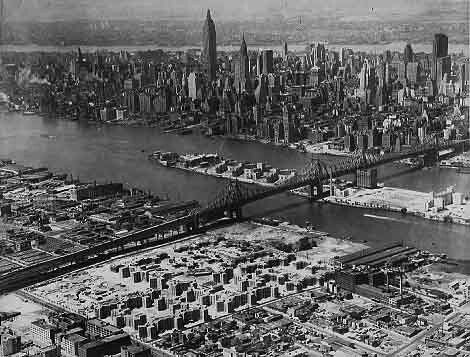


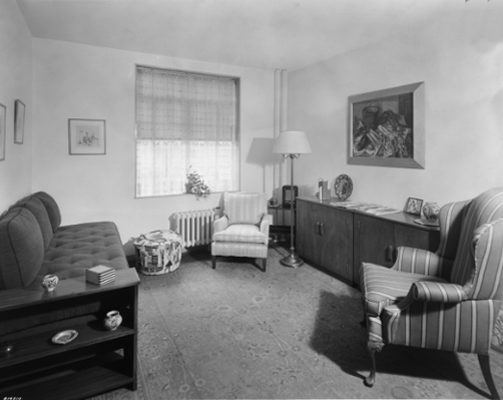
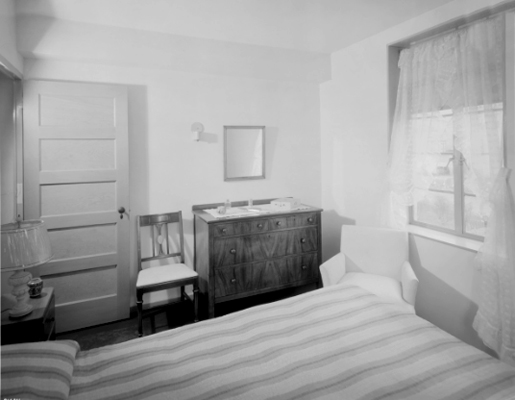
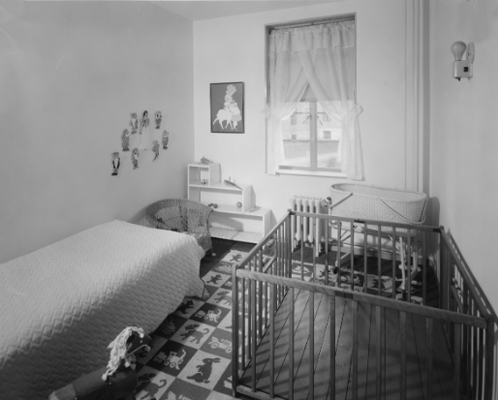
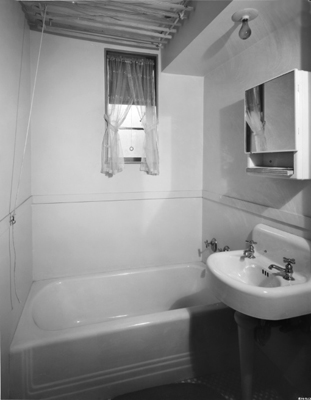
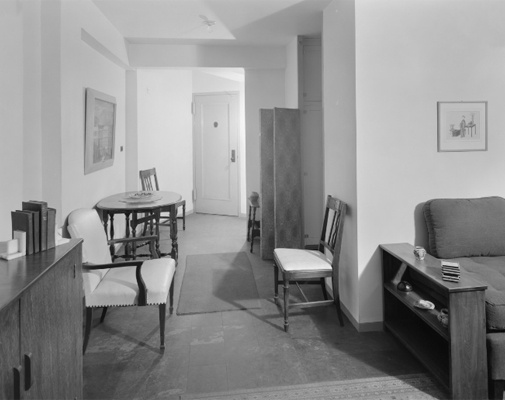
(Above) Model Queensbridge Houses apartments in 1939 as per
NYCHA's utopian vision of
what the project was supposed to be when they opened.
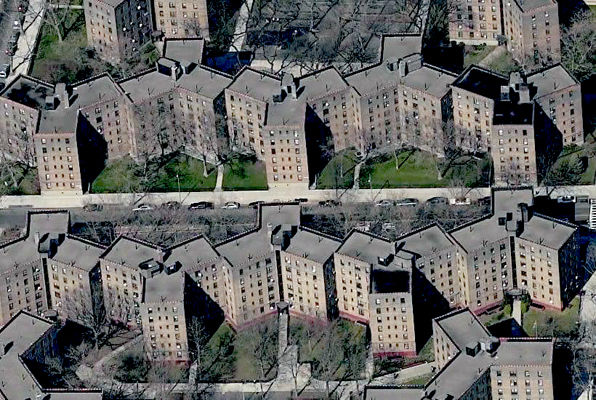
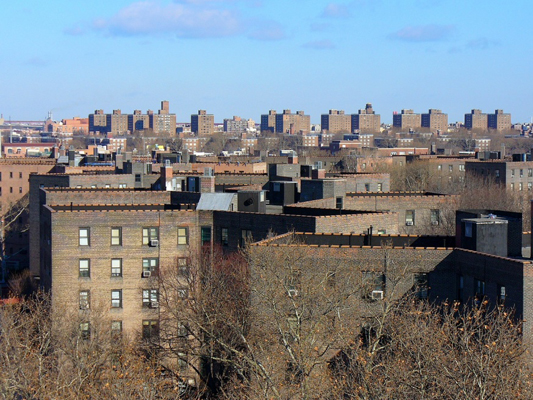
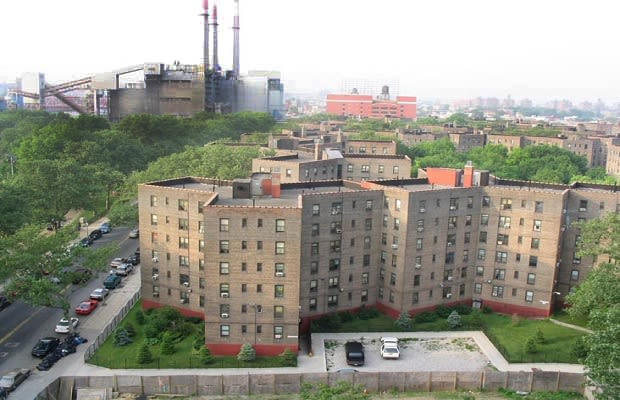
Until the 1960s, New York City had been virtually the only places in the United States where public housing projects were not segregated and Queensbridge was living up to its utopian intent, having given decent housing to many local residents who grew up in the blighted Long Island City neighborhood before the projects were built, like Adeline and Paul and their three daughters.
When Lorraine was a child growing up in Queensbridge, it was not a racial ghetto and it was populated by a mix of upwardly mobile skilled working and middle-classes who settled in the projects in 1939 at the end of the Depression, just on the eve of the big boom in war industry jobs that would come with World War Two. And when the war ended, the Marshall Plan to rebuild Europe so communism can't, and the Cold War arms race, and the war in Korea, kept Americans working in factories and offices for the next twenty-five years into the 1960s.
Lorraine was growing up in times of hope and upward mobility. Many people who lived in Queensbridge had steady work from the nearby industrial neighborhoods in Queens, before industry and manufacturing died in New York in the 1960s. When Lorraine was seven years old, her adult neighbors on their floor, other than the few like Adeline who was born in the USA, were born in England, Italy, Germany, Ireland, and Canada. Their faces and their incomes were mostly White, and their kids were first generation American born on their way up. (United States 1950 Census).
Adeline's three daughters will all leave Queensbridge by 1960 through marriage.
When she was 24, Maria* married up in class in 1956, the son of a radio engineer, born and partly educated in Paris where his father had been posted in the 1930s.
Lorraine the youngest, jumped the order and married next in 1959 at the age sixteen but we don't know much about her husband.
Her middle sister Gia* married the next year in 1960, to a local boy from QB of Italian descent who rose to be a deputy director in the US Small Business Administration and a known figure in New York and Long Island. Both sisters' families prospered throughout New York City, Long Island, and into New Jersey and Florida.
GRANDMA COOKIE LEFT BEHIND
After that, only Adeline was left living in a relatively
decent middle-class public housing complex.
But just as Adeline's three girls married off leaving her alone in 1960 in a nice apartment, the NYCHA changed the economic and racial balance of Queensbridge by transferring all families whose income was more than $3,000/year, a majority of whom were White, to newer middle-income housing projects elsewhere, and replacing most of the departing Queensbridge tenants with impoverished African-American and Latino families.
This policy was originally intended to provide safe and sanitary housing to many low-income African-Americans and Latinos who now desperately needed it. Especially since the notorious New York City Planning Commissioner Robert Moses and New York State in the 1950s ripped huge trenches like the Cross Bronx Expressway through Black and Latino neighbourhoods that were thriving and had traditional community and family roots and established businesses. All that was destroyed to make way for expressways, displacing tens of thousands of African-Americans and Latino's, whose neighborhoods were "sacrificed" for expressways.
But Adeline Montalvo did not earn the $3,000 income threshold and she was left behind, trapped in QB as the utopia became a dystopia. She was probably transferred to a smaller apartment in the same building.
The
departure of upwardly mobile middle-income earners from QB and the
concentration (that's why they call it a "ghetto") of desperately
poor, marginalized and unemployed minorities of color into the confines
of the dense housing projects by the end of the sixties, changing both
the economic ecology and demographics of the projects, at the same time
as manufacturing job vanished and the city began its decline into near-bankruptcy, collapse of social
services, unbridled drug abuse, race riots, murder and mayhem, radicalism,
and guns; QB exponentially got the worst of the urban jungle.
What happened to Adeline, is old theme in urban America of the
1960s-1970s, 'the little old lady on a widow's fixed income pension with
granny lace curtains in a house that once was nice' but was now in the
middle of a crack city ghetto land. In the movie versions, Charles Bronson
would come by and blow away the gangs and save the old lady. Too
bad Adeline and Lorraine weren't in a movie. Real life goes
different.
The nice circular "town square" in the center lined with stores and services, became known as the "The Hill" and in the 1970s-1990s it was a type of "Needle Park" drug market, except for drugs far worse than heroin. The green spaces and parks were covered in needles and crack vials, the garbage overflowed, the benches rotted as city services collapsed under the weight of strikes and budgetary cuts. Nobody would go to the park anyway; it became too dangerous. All the animals came out at night.
By 1986 toward the new heights of the crack murder epidemic in New York, QB would have the distinct notoriety for having the most murders of any public housing project in New York City.
As all this by 1969 was taking its first bite and hold on QB, Lorraine was coming home to a place that was on the way to hell. Her two children already rooted there as schoolchildren,
perhaps as early as 1965. The curse of the McGraws.The irony was that Queensbridge, one of the largest concentrations of poverty and dispossession in the United States, was just across the river over the bridge, a two-stop subway ride away on the F-train, into one of the largest concentration of wealth and power: Manhattan's Upper East Side at Sutton Place.
The curse of the McGraws: social irony.
The projects were also the same two subway stops away from Cottingham's "Girl Ghetto" hunting ground.
The curse of the McGraws: a serial killer's hunting ground two subway stops from home.
And nearby - in Hunter's Point, Queens, in the warren of warehouses in Long Island City, were computer training facilities where on occasion Richard Cottingham had to attend to keep his computer operator's skills at Blue Cross Insurance updated. On one of those trips out to Hunter's Point, Cottingham will encounter Lorraine for the first time on the way, selling herself under the rail and road overpasses coming off the bridge and the commuter trains and subways.
The curse of the McGraws: the intersecting paths between victim and perpetrator.
If she doesn't come to him, the wolfen will come to her, for her sanpaku eyes.
All this in January 2021, I was only surmising and deducing and suspecting and scratching and digging at like a sore. Cottingham was not saying much. All we knew was that Cottingham and Lorraine orbited several mutual locations, but where they exactly they crossed paths and collided resulting in her murder on February 27/28, 1970, was still unclear - in New York City or off 9W in Rockland County.
Was Lorraine, the "girl off 9W?"
LORRAINE'S LAST ARREST: NYPD 18TH PRECINCT AND "THE GIRL GHETTO"
1969
Lorraine after her release from Matteawan and return to her childhood home
to her mother, will reappear in the police records just one more time as an
offender, before she appears for the last time as a victim.
Looking at that last arrest of hers, would raise a huge red flag for me and draw me deeper into suspecting Cottingham as having murdered her before he got around to confessing to killing Lorraine.
October 5, 1969, Lorraine was arrested for the last time, five months before her murder, under the name of "Sherrie Daniels", again on an PL §230.00-2B prostitution charge, but in a different NYPD precinct this time: the 18th Precinct.
Today the 18th Precinct is designated as the "Midtown North Precinct" but the precinct station is the same, located on 306 West 54th Street in Manhattan just south of Central Park between Eighth and Ninth Avenues. The precinct encompasses a much more upscale part of New York although in the 1960s-1970s, on its western fringes starting at Columbus Circle and at Eighth Avenue, there were some seedier hotels and blocks.
This would be Lorraine's first and only arrest in the 18th Precinct and it made me sit up and pay attention to both Cottingham and Lorraine because the eastern perimeter of the precinct bordered on the very upscale Upper East Side Lexington Avenue, where Bloomingdale's was located, two blocks from where the Queensboro Bridge ramps touched-down, where the subway stations for trains to and from Queens were located, and the First and Second Avenue so called "Girl Ghetto" and its hundreds of singles bars like Maxwell's Plum, Sugar Tree, Play Street and nightclubs like the Ali Baba and the Tittle Tattle, and where Cottingham cruised almost nightly for pick-ups and sometimes for victims. (See: Part 1-A: Building a Rapport with the Torso Serial Killer)
Lorraine was living in the Queensbridge projects with her mother and two children, two subway stops away across the river from the "Girl Ghetto" which was teeming with after-work herds of horny males with small brains and a fat wallets who would as happily, as the saying went, "date it out or pay it out, it will add up to the same tab."
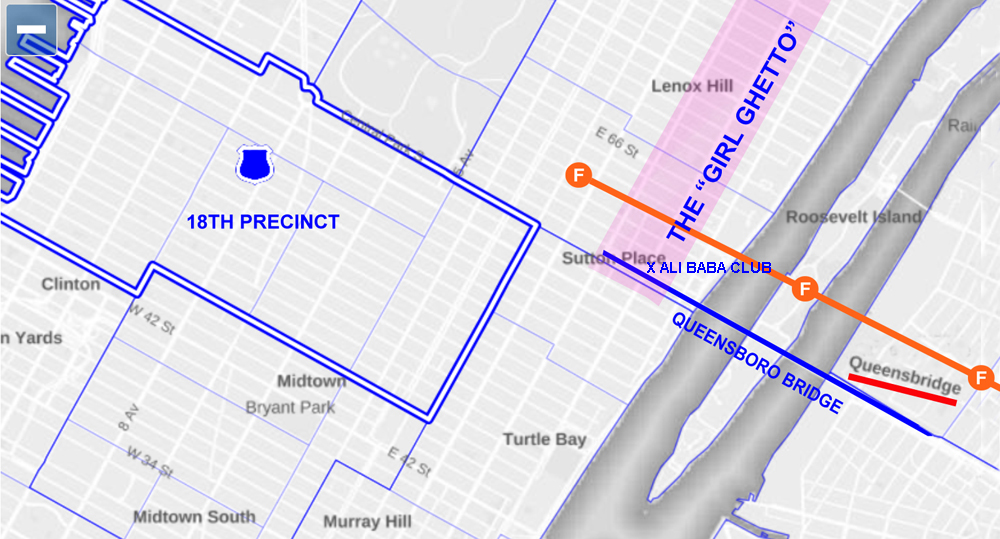
LORRAINE IN THE ALI BABA
I knew the Ali Baba as a spot Cottingham encountered Jennifer's mom
Deedeh Goodarzi on the weekend he murdered
and beheaded her. Deedeh's last call home was at 2:00 am Saturday
morning from the Ali
Baba. This is 1979, before cell phones. After that Deedeh was on
the dark side of the moon out of touch until Sunday
morning at around 9:00 am when firemen responding to smoke coming from Room
417 of the Travel Inn on W. 42nd Street found Deedeh headless torso roasting
on a smouldering mattress. I was checking into the hotel that morning. I was
twenty-three years old in 1979 and the rest, is why I am here writing today.
And still looking for Deedeh's head. See:
Part 1-A
I suspected that Lorraine might have crossed the bridge for a better class of clients just two subway stops away and might have encountered Cottingham in that area. Maybe he abducted her from there and "dropped her off" in Rockland County, the way he "dropped off" a number of victims from Manhattan in Bergen County in one direction and Nassau County in another direction. Again, Cottingham at this point in 2021 was not yet admitting to anything other than a vague reference to "a girl off 9W."
Cottingham and I talked about Deedeh and the Ali Baba a lot, what it was like inside. It was one of those classic black and white movie gangster night clubs where people came to watch both the entertainment and the gangsters.
What I did not know until much later from my follow-up interviews with Cottingham, was that it was Lorraine who introduced Cottingham to the Ali Baba! He had gone by it several times and looked in through the windows but never went in until Lorraine told him, and proudly, that she was working in there and had moved up off the streets. He already knew Lorraine from the street and liked her.
Cottingham became so frequent a customer over the next ten years at the Ali Baba that he was recently recognized by an elderly inmate who had worked the door there forty years ago. After he murdered Deedeh he stopped going; too many people had seen him with Deedeh - but nobody remembered. He was the invisible serial killer man.
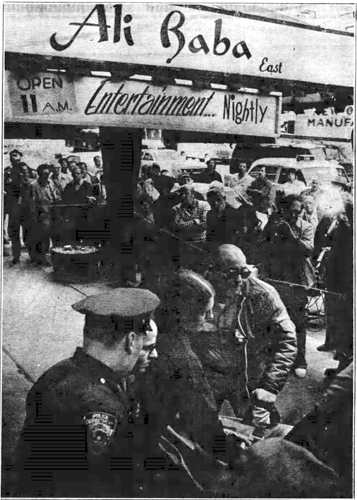
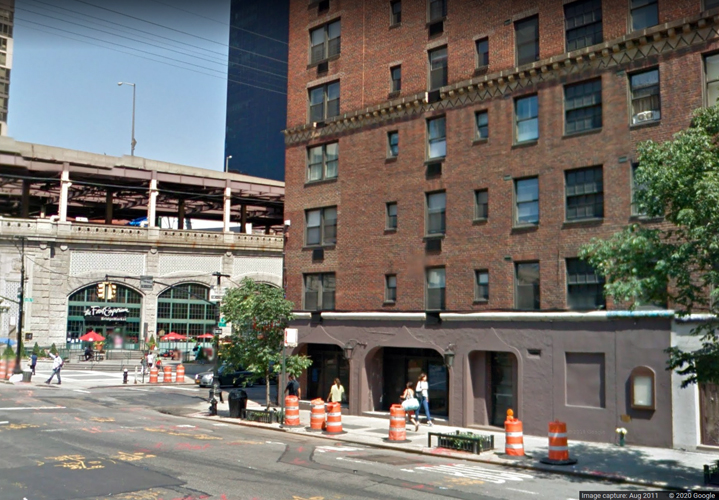
The Ali Baba a mob-owned club next to the
Queensboro Bridge on First Avenue..
The traces of its Arab-themed arches survived until 2011, before they were
covered over.
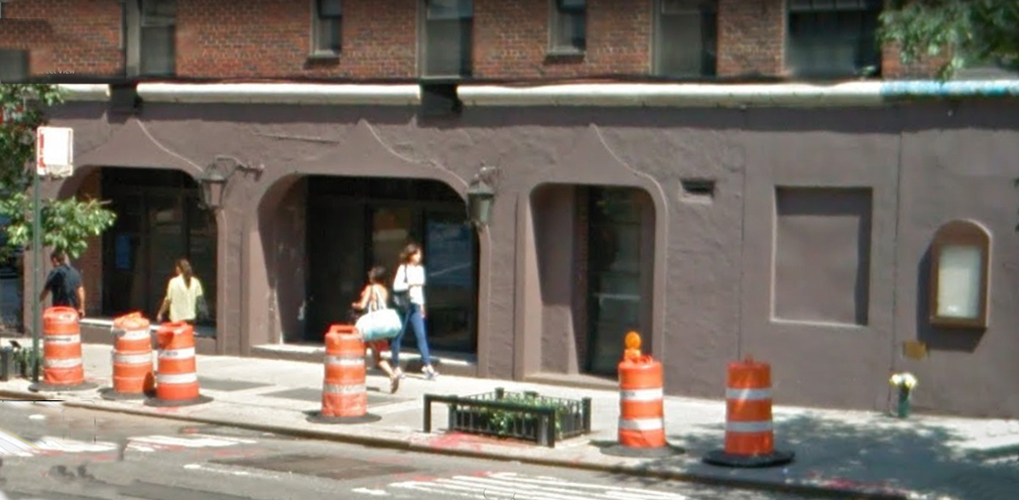
The Ali Baba was owned by the mob and for a sex worker to be allowed to work inside the club the way Deedeh did, she had to be 'sponsored' by a made member of one of New York's Five Mafia Families (Bonanno, Colombo, Gambino, Genovese or Lucchese family) or an 'associate' of. Deedeh had been sponsored to work in the Ali Baba by Vito Di Tomasso (Tamasso) an associate with the Lucchese Family who managed a social club on Morris Avenue in the Bronx, according to the NYPD investigation into Deedeh's murder before Cottingham had been positively identified as her killer. Nor could a girl be visibly a junkie to work in the Ali Baba -- it was a high class mob club in a high class neigborhood. Sex work in the club was a discreet high-yield low turn-over kind of thing; once a girl left with a customer, she was not allowed to return until the next night, because she could not be "seen working."
In that last year, Lorraine might have been more together than we might know, and "connected" to a made member or organized crime, or connected to somebody who was "connected", considering she was permitted to solicit sex-work clients inside the Ali Baba.
Lorraine was half Puerto Rican, half Italian, but she was Italian on her mother's side, the heart and blood side of her, and some of her family married Italian, and married tight, and there is an extended network of in-laws, cousins and uncles and nephews and nieces. I mapped her family through the US Census records from 1930, 1940 and 1950 and marriage licenses and ancestry websites.
Lorrain's middle sister Gia* (a pseudonym) married an American born Italian from a building in the same Queensbridge projects, just the way Adeline married Pablo from the same neighborhood in the 1930s before Queensbridge was built on top of it. People didn't go far in those days, they stayed close to home and often married close to home, went to school together. It could easily have been just a matter of time before somebody in her extended Italian family was connected or connected to somebody who was connected or a "made" in that dense interrelated old world of ethnic enclaves of ambitious American-born people of Italian descent in Queens, Bronx and Brooklyn of the 1930s-to-1960s.
It's not a cliché, the Mafia, the Five Families, and being Italian in New York City in that era. It was the golden age of Italian organized crime and its roots went deep into the community. Organized crime consisting of others ethnicities would rise later, from Colombian to Russian organized crime groups to the current El Salvadorian and Venezuelan which have displaced the primacy of traditional Italian 'cosa nostra' organized crime.
Somebody "made" or "connected" had to vouch for Lorraine to work in the Ali Baba; somebody she knew, or somebody she knew, who knew somebody, to whom Lorraine might have reached out for help.
Nothing is what it seems and mostly with cold case homicides, if you are lucky, you get things right but for all the wrong reasons.
"LICENSED ADULT ENTERTAINER/CABARET PERFORMER?"
Lorraine it, was alleged, had obtained the period 1969-1970, an
"adult entertainer license" or a "cabaret license" either from the State of New York or from the
local municipality in Rockland County. An informant shortly after her
murder claimed that Lorraine worked in bars and clubs in Rockland Lake and
Congers. (See interview with Sonia Ruiz McGraw,
Licensing of "cabaret performers", striptease performers, adult entertainment premises, along with liquor licenses, had been for decades an attempt to exercise some measure of control and authority over "vice" in many parts of the United States. The rational and logic behind licensing adult entertainers, as per one licensing commission's preamble, was to "license entertainers in the adult entertainment industry to prevent the exploitation of minors; to ensure that each such entertainer is an adult; and to ensure that such entertainers have not assumed a false name, which would make regulation of the entertainer difficult or impossible."
Licensed establishments, that sold liquor and/or featured "exotic" dancers, were regulated as to the limits that dancers had to adhere to, to what state of undress they could perform, the distance they had to keep from customers, etc, and one of the regulations stipulated that only licensed adult entertainers could be hired by the establishments offering adult entertainment.
Whether this could have been an attempt by Lorraine to distance herself from prostitution as sex work, or distance herself from the risks of arrest and the dangers of the street, or merely a convenient cover to engage in a higher class of sex work, is not clear. But again it's curse of the McGraws in that Lorraine who should have been safer off the streets, and might have been licensed to work legally in the bars and clubs along 9W, was murdered by Richard Cottingham while doing so.
At this point in 2021 Cottingham was not saying much, when I was striving to understand when and where and how exactly did Cottingham and Lorraine cross paths.
But much later in follow-up interviews with him in 2022-2024 after he confessed, Cottingham had told me that when he encountered Lorraine in a Rockland County bar the night he killed her, it was not in a place where exotic dancers performed. There was an ordinary dance floor for customers and Lorraine was drinking at the bar when Cottingham approached her having recognized her from New York City where he had encountered her before. Cottingham already knew her from Manhattan and from Queens where they had multiple assignations previously for at least two years. Cottingham stated that he immediately asked her if she recognized him, and that she replied "of course I do." Cottingham laughed, "of course she did not recognize me at first." She was not a stranger to him, and he had to remind her of where they had known each other from. Lorraine had told him she had come there with a girlfriend to "work the Jersey boys coming up to Rockland County on the weekend."
But in 2021, I did not know any of that.
I never was able to successfully trace the illusive "adult entertainer license" Lorraine was supposed to have had or even confirm that such "adult entertainer licenses" existed in New York State in 1969-1970. Lorraine perhaps had a "cabaret performer's license." Moreover, typically when a person applies for an "adult entertainment industry" licenses they are subjected to a background police check if they had a criminal history for minor crimes like prostitution, dealing drugs, stealing wallets, etc, before being issued the licence. Lorraine's criminal record could have precluded her from being licensed.
In an interview with Steve Lieberman Rockland/Westchester Journal News on August 29, 2022, Lorraine's granddaughter stated that she believed Lorraine had a cabaret performer's license and was dancing in a club as an "adult entertainer" in Rockland County on the night of her murder. (see: 'Torso Killer' Richard Cottingham claims two more Rockland murders.)
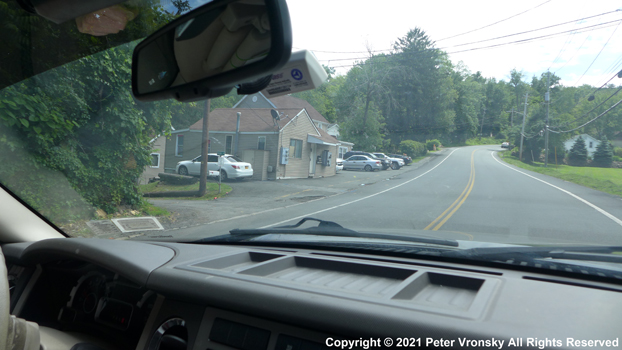
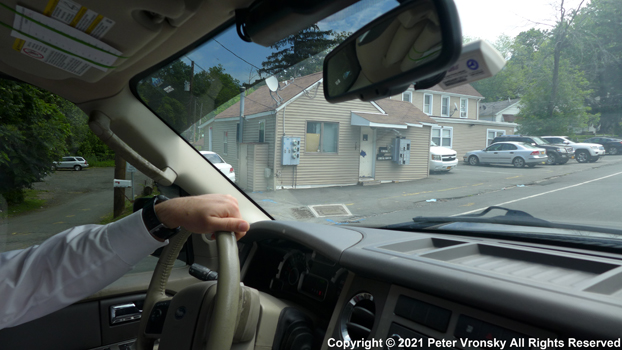
The former Bobin Floridian Cottages where it
was alleged Lorraine worked and stayed as an adult entertainer perhaps the
night of her murder.
LOCATING LORRAINE'S FAMILY TODAY: ANCESTRAL BLACK SHEEP WHORE-SHAMING
After I identified Lorraine as a likely victim, Conor and Yan
next asked me an extraordinary thing. Could I locate and reach out to Lorraine's family
members and find out more about her in 1970?
I was a little surprised, as I assumed the two cops had better resources and access to databases than I had to trace Lorraine's family and would want to do the interviews themselves. But I knew too that they were busy with 'day jobs' in their work - ours was an ad hoc task force - not one officially endorsed by their bosses, who at least looked the other way without obstructing. Yan Salomon introduced me to the DEA Chief in New York where we became based, and he was very encouraging and supportive, and fascinated with the Cottingham story, and as long what Yan was doing did not interfere with any ongoing operations the DEA was running, he was cool with it.
Cops can sometimes be helplessly tied up in red tape and no funding. I realized by now that most cops in New York and New Jersey could not phone or text me in Canada (a long distance destination for them) on the cell phone plans their departments had furnished them with. They would e-mail me to ask me to call them.
And nobody was getting paid overtime on any of this.
So I made an attempt at locating family members and interviewing them on what they might know about Lorraine, because it could assist us in understanding the scope of her connection to Cottingham. At this point we were not ready to go back to Cottingham with Lorraine's photo and identity without learning more about her and exactly how she crossed paths with him.
Eventually through findagrave.com and an ancestry website, I located a (grand) nephew from Lorraine's family, from Montclair, NJ, Scooter Perdue*(pseudonym) a dog trainer who operated a shelter and a kennel-training school and assembled a public ancestry profile around Adeline Montalvo's family tree. He belonged to Maria's* branch of the family.
One thing I noticed right away on Scooter's ancestry website, Lorraine, his grand-aunt, or great-grand-Aunt, if I correctly put the relational branch together, was not listed at all. It was as if she never existed. Nor were Lorraine's son Billy* and daughter Emi* listed. It the family tree had been sawed off like a dead rotted limb at Lorraine's branch.
And Lorraine's younger sister Gia* and her Italian local QB husband branch, was obscured as "private."
On January 29, 2021 I got a hold of Scooter Perdue* and informed him that Lorraine's case had been re-opened and requested assistance in contacting senior family members to get a better fix on Lorraine and her history.
I might as well have brought up a bowl of shit under his nose, in the way he responded.
Lorraine was less than a sheltered kennel dog to him.
His bottom line, to the bitter end, (even in 2024 in few weeks before releasing these excerpts on-line, when I asked if there were any 'kinder' pictures available of Lorraine other than the one mug shot of her during her arrest) he responded with a cold fish, "I don't think my family wants any more involvement with the situation, I'm sorry." Nobody from the Perdue* branch of the family wanted to help with pursuing a case closure for their ancestor Lorraine. "Fuck her" was the basic response from that branch of the family.
By 2021 I had dealt with over a dozen families of cold case victims, including those who had been sex workers. It was inconceivable to any of them to turn their back on an unsolved murder of a grandmother, a mother, a sister, or even a sister-in-law, no matter what led to their murder. In one case, a woman who had married into a family of a murder victim, her late husband's sister, whom she never met, and now was a widow, she and her daughter were the last remaining link to her husband's murdered sister, and the two of them hang in there as if she was their own flesh and blood sister and aunt, and to this day push and lobby the police in the jurisdiction where the murder still remains unsolved for over fifty-years. That's what families do.
Historically, in the human species, no family or clan leaves their murdered ancestors unavenged or without justice. It's fundamentally anthropological.
ANCESTRAL WORSHIP AND THE FEAR OF THE DEAD
Necrophobia ("fear of the dead') is the worship, respect, reverence and fear
of the dead, especially of ones own relations and
ancestors. According to many anthropologists it is a
foundational element in evolution of humans from the stone age into the age
of agrarian civilizations. In fact the first traces of civilization are the
archaeological remains of the first ritual burials of the dead; the first
"decent burials." Before then we used to to 'dump' our dead (or eat
them.)
We had to become civilized and organized to care for the dying and
the dead we feared. We feared them so much we nailed and staked them to the
ground in their coffins, tombs and graves, and laid huge stones on them to
ensure they don't get up and get us for disrespecting them. It is still
customary for most cultures to put headstones over our dead for that
forgotten reason. One of the
first "special things" along with cave painting that the humans separate
themselves from the rest of the animal kingdom was our care for the elderly
among our species and the 'honor thy father' both respectful and fearful
burial once they were dead that we afforded them.
See: Tsaliki, Anastasia. “Unusual Burials and
Necrophobia: An Insight into the Burial Archaeology of Fear.” In
Deviant
Burial in the Archaeological Record, edited by
Eileen M. Murphy, 2:1–16. Oxbow Books, 2008 and Akop Nazaretyan. “Fear of
the Dead as a Factor in Social Self-organization.” In
Journal for the Theory of Social Behavior, vol. 35,
no. 2, 2005, pp. 155–69).
That's all of humanity except for Scooter Perdue* and his family. He had to be a fucking goof. A freak
of human nature. An anthropological retard. To respond
with such shame to a break in an unsolved murder of one's ancestor - even if she
was a sex worker - the "family whore" - and to refuse to help in investigating
her murder, with a trite we do "not want any more involvement with
the situation" was disgusting; in almost any culture around the world that kind of disrespect and abandonment of one's
ancestors - especially
those still in their unquiet grave - is not only despicable, but a species
of cardinal
sin.
The curse of the McGraws followed Lorraine to her grave and her afterlife and into her purged and redacted ancestral lore.
Ghosts actually are the dead haunted by living assholes. May the curse of the McGraws inhabit the Perdues* from now on.
With family blood like Scooter Perdue*, it's amazing that Lorraine at least had been given a 'decent burial' in consecrated ground and a space for her name on a headstone, and not dumped unwanted into a potter's field the way Jennifer's mom Deedeh was buried in a mass grave on Hart Island, New York's potter's field for unwanted and abandoned dead. (See The Hart Island Project.)
In the end it was Lorraine's aunt from her mother's side of the family who stepped up, Adeline's younger sister, Isabella "Bella" Merango and her husband Rocco, who gave shelter to poor Lorraine's battered broken body in their family plot in Mount Saint Mary Cemetery in Flushing, Queens County, New York, where she rests today. She was buried there on April 8, about five weeks after her murder.
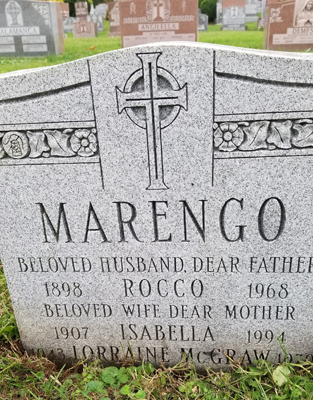
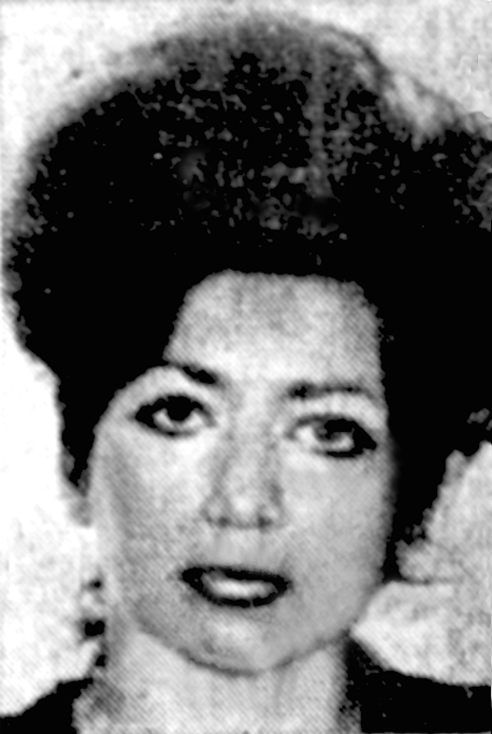
LORRAINE McGRAW: LESS-DEAD and NEVER-WAS
Perdue's fucked-up attitude is part of a sick pernicious
sub-culture that many argue is the reason we have so many serial killers and
so many murdered women.
Criminologist Steven Egger argues, it was not that there were more serial killers in the modern age, but that there were more available victims whose worth was discounted and devalued by society. He suggests that society perceives certain categories of murder victims as “less-dead” than others, such as sex workers, homeless transients, drug addicts, the mentally ill, runaway youths, senior citizens, minorities, Indigenous women and the inner-city poor.
These victims are all perceived as less-dead than, say, a white
college girl from a middle-class suburb or an innocent fair-haired child.
Sometimes the disappearance of these victims is not even reported.
Criminologists label them the “missing missing.”
Egger writes:
"The victims of serial killers, viewed when alive as a devalued strata of
humanity, become “less-dead” (since for many they were less-alive before
their death and now they become the “never-were” and their demise becomes
the elimination of sores or blemishes cleansed by those who dare to wash
away these undesirable elements."
(Steven A. Egger. The Killers Among Us: An
Examination of Serial Murder and Its Investigation. Upper Saddle River,
NJ: Prentice-Hall, 1998)
We popularly regard serial killers as disconnected outcasts, as those who reject societal norms, but more often the opposite is true. In killing sex workers, Jack the Ripper, for example, was targeting the women that moralistic holier-than-thou Victorian society chose for its most vehement disdain and scorn.
Gary Ridgway, “the Green River Killer,” who was convicted for the murder of forty-nine women, mostly sex workers, said he thought he was doing the police a favor, because they themselves could not deal with the problem of prostitution. Ridgway told police, “I thought I was doing you guys a favor, killing; killing the prostitutes. Here you guys can’t control them, but I can. You can’t hurt anybody. You can’t; you can arrest them and put cuffs on them, might be a little bit rough on them a little bit. But you can’t stop the problem. I was doing you a favor that you couldn’t, you guys couldn’t do.”
As Angus McLaren observed in his study of Victorian-era serial killer Dr. Thomas Neill Cream, who murdered at least five victims (prostitutes and unmarried women coming to him seeking abortions), Cream’s murders “were determined largely by the society that produced them.”
The serial killer, according to McLaren, rather than being an outcast, is
“likely best understood not so much as an ‘outlaw’ as an ‘over-socialized’
individual who saw himself simply carrying out sentences that society at
large levelled.”
(Angus McLaren. A
Prescription for Murder: The Victorian Serial Killings of Dr. Thomas Neill
Cream Chicago: University of Chicago Press, 1993.)
Social critic Mark Seltzer suggests that serial killers
today are fed and nurtured by a “wound culture.... the public fascination
with torn and open bodies and opened persons, a collective gathering around
shock, trauma, and the wound,” to which serial killers respond with their
own homicidal contributions in a process that Seltzer calls “mimetic
compulsion.”
(Mark Seltzer. Serial Killers: Death and
Life in America’s Wound Culture. New York: Routledge, 1998.)
Or, as the late Robert Kennedy once put it more simply, “Every society gets
the kind of criminal it deserves.”
(Robert Kennedy. Statement by Attorney
General Robert F. Kennedy to the Permanent Subcommittee on Investigations of
the Senate Government Operations Committee. Washington, DC: September
25, 1963.)
NEWS MEDIA REPORTING OF THE MURDER OF THE LESS-DEAD
News media is probably the single worst contributor to the “less-dead”
syndrome. In searching for cold cases that could be linked to Cottingham in
old newspaper reports on newspapers.com, only a sliver of murders in
1960-1980 are reported. For every unidentified body of a suspected runaway,
or drug addict or sex worker that is given a few lines in a newspaper,
thousands go unreported; the press takes no interest in them because their
readers do not. The press took an interest in Lorraine for about a week,
because she was a "nude beauty" and had beautiful "almond shaped eyes."
After that the press moved on, as did the police, and as did her family.
For the approximately 25 unsolved murders I found that fit Cottingham's MO and signature reported in the newspapers in New York City between October 1964 when Cottingham began working in the city and May 1980, there are 8,559 unsolved murders! Almost all of them, were not even mentioned in the newspapers. (See: Part 1-C: Mapping the Torso Serial Killer's Mind and Murders)
In the mid-1990s, for example, the trial of William Lester Suff, who murdered thirteen women in the Lake Elsinore region of California, went virtually unreported. Who has ever heard of William Suff or of his victims? Suff killed drug-addicted street prostitutes and left their bodies behind strip-mall garbage dumpsters, posed so as to call attention to their drug habits. But Suff went on trial in the middle of the O. J. Simpson case. What are thirteen dead crack whores compared to two upscale victims in tennis-white Brentwood slaughtered at the hands of a celebrity?
And how about Joel Rifkin, who murdered as many as seventeen prostitutes in
the New York and Long Island area? The media abandoned his story to cover
Colin Ferguson’s massacre of six “respectably employed” suburban commuters.
Joel Rifkin’s trial, in which he was convicted of nine murders, wrapped up
in relative obscurity despite the number of victims. We might not even know
his name if an episode of Seinfeld had not made it a butt of jokes.
(Peter Mehlman and Carol Leifer. “The
Masseuse,”
Seinfeld, NBC TV,
episode first aired November 18, 1993.)
For the media covering serial murder, it is not the number of victims that
counts anymore, but their celebrity status and credit rating, the trade-off
these days is one upscale SUV in the driveway for every ten dead hookers in
a dumpster.
Politicians too care nothing about the less-dead other than the
inconvenience their dead bodies present to the politicians' constituency.
When some twenty-five indigenous women went missing in Vancouver, Canada, in
the late 1990s, their families begged that the Police Board offer the same
100 thousand-dollar reward it had offered the previous month for information
about a series of residential garage break-ins on the city’s affluent west
side. The mayor scoffed at the families’ petition, saying, “Some of these
girls have been missing for a year. All of a sudden . . . it becomes a major
event.” He wasn’t financing a location service for hookers, he told the
families.
(Lora Grindlay. “Police Don’t Think a Reward
Would Help.” Province, April 7, 1999, p. A18.)
The Vancouver Police Department responded that they “would consider
supporting ‘mini-rewards’ of $1,000 to the women themselves if they make
their whereabouts known to police.” The police position was that “the
women were capriciously hiding in an attempt to taunt the police and the
women could be lured out by a $1,000 ‘reward.’”
(Patrick Moores. (Re)Covering the Missing
Women: News Media Reporting on Vancouver’s “Disappeared.” Master’s
dissertation, University of British Columbia, 2006, p. 62)
The fragmentary remains of some of the missing women were eventually found among the forty-nine victims whom Robert Pickton was later charged with killing and dismembering on his pig farm. When he was arrested in 2002, he said he was disappointed not to have made it an even fifty.
Serial killers, in other words, partly take their cue from society from us - as its values are filtered through a combination of history, popular discourse, mainstream media, culture and subcultures, and finally from families like Perdue* who shame their own ancestral dead; shame on them.
That's how for fifty-fucking-two years the case of Lorraine McGraw lay forgotten and untouched, even though her killer has been in prison since 1980. Until Jennifer and I came around asking Cottingham questions and nagging the cops to do something. Weight like that, wear you down, and Jennifer and I were both drowning in procedural quicksand the cops were dragging us down into. And it was going to get worse.
And now that I finally found somebody from Lorraine McGraw's family, Scooter Perdue* turned out to be an infidel whore-shamed dickhead.
A GRANDDAUGHTER SHOWS UP FOR HER GRANDMOTHER LORRAINE
When I did not hear anything further from him about Lorraine's family, I assumed he did not get any helpful information from any of them.
Then in late February or early March, Conor told me that Lorraine's granddaughter had reached out to him and had come down to see him in S. Nyack, regarding Lorraine's murder. I never knew a granddaughter existed, presumably the child of either Lorraine's daughter Eli McGraw* or her son Billy McGraw.* Scooter Perdue*'s ancestry website had purged Lorraine's "less-dead" branch of the family, the shamed 'black sheep.'
Conor said the granddaughter had more questions for him than answers. She was his source and witness, and I did not ask him for her name or contacts if he did not offer them to me himself, nor could I reach out to her myself, without Conor's permission as I only knew of her existence from him - it was confidential police investigative information.
Nor did I have any reason to reach out to her. She had been asking the questions. My primary brain function at this moment was to ask questions; not respond to them. And moreover, I had just been recently introduced to Conor by Yan Salomon a few months earlier, had not met him yet in person face to face, (we were in pandeic border lockdown in 2020-2021) and I did not really know him that well, and I wasn't comfortable with asking him anything further than what he offered to share.
One thing, that I did not like, however, and raised for me the first red flag on Detective Conor Fitzgerald, was what I thought was a disrespectful comment he made about Lorraine's granddaughter. He described her pejoratively as "ghetto" and told me disdainfully that she showed up "smelling of marijuana" when she came to see him.
In the back of my mind I wondered, why is Conor telling me this about a witness and murder victim family member?
While cops have prejudices and filters like all the rest of us in our instinctual assessment of people we meet, and it was not exactly an issue for me his thinking that way, but it was a disrespectful and denigrating thing to do in saying it to me, spreading the toxin. It wasn't any of my business whether the granddaughter smoked weed and the comment was intended to degrade her in my perception, without her even knowing it was happening to her. I didn't say anything to Conor, not to discourage him from continuing to share shit with me, but it nagged at me. It bothered me.
Moreover, I am Canadian, where cannabis is legally sold in corner stores: I
was not impressed that the granddaughter smelled of marijuana, in fact, I
felt almost defensive about it on her behalf, protective of her, whoever she
was. And more. That she had shown up for her
grandmother, was the foremost most important and admirable thing, even if she had shown
up smelling of ghetto weed. I liked her. Whoever she was. To me
she was a hero, whoever she was and whatever she smelled of.
In any regard, I left it alone, as in March 2021, the Torso Killer
confession "Make
Jennifer famous on TV" ad hoc task force, was in the
middle of something major and Lorraine McGraw was now moving up to the top
of the list. (See Part 10)
SO_KNEEYA
On March 28, 2021, I found the following text in my Facebook messenger from
somebody I was not "Facebook friends" with.
They were using the handle "So_Kneeya".
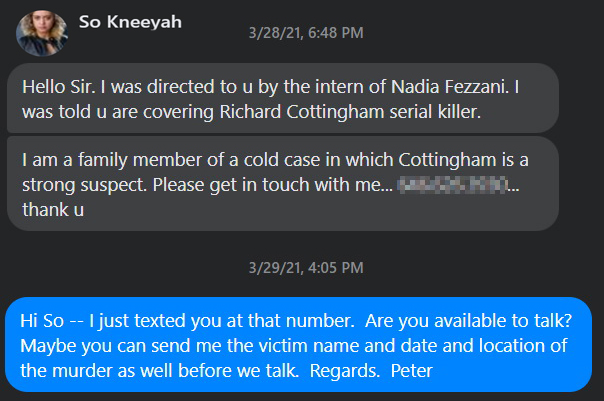
When I conducted a reverse check of the phone number they furnished, it came back to a Sonia Ruiz.
I think it took my boomer generation social media-retarded mind a few days before I recognized her Facebook handle "So_Kneeya" as a phonetic sounding out of "Sonia." That was how she wrote a lot of her posts on her page; phonetically, like graffiti, in a secret language of her own making, that even some of her Facebook friends could not decipher or understand.
Although I was not sure 100 percent, I of course suspected that this was the "ghetto weed-smelling granddaughter" of Lorraine McGraw that Conor had described to me, although at first glance there was nothing on her page mentioning Lorraine. But there were a lot of references to Queensbridge and her having come from there; it had to be a McGraw. I asked her to send me the victim's name she was purporting was her "family member" to confirm I wasn't making assumptions and she confirmed it.
What shocked me about her message, however, was that she was aware that Richard Cottingham was "a strong suspect" in her family member's murder! What the fuck!
We didn't know for sure if Cottingham really was "a strong suspect" yet; we were nowhere near sharing information like that with family, a suspect's name on the basis of the tenuous information we had, most of it my 'witch-doctoring' read of his forensic geography and signature psychopathology. My PhD doctorate was in serial spies, not serial killers.
But all this raised for me a second red flag on Conor; he appeared to me to be too "blabby" and loose tongued for a cop, a little ambitious in already solving the case...
Sonia Ruiz's message in March 2021, was going to be as life-altering as Jennifer's was when she first reached out to me in the spring of 2017.
Like Jennifer's incarnation in body and soul of her murdered mother Deedeh, Sonia would become in the same way, the incarnation of the body and soul of her murdered grandmother Lorraine. (Part 1-B: 2018-2019 - Searching for the Severed Heads, "Hurricane Jennifer" and Watching the Detectives) )
And Sonia Ruiz would be much more than that, for Deedeh's murder had been uncovered and solved without me, for I was nothing but a bystander in 1979 for ten seconds at best; Lorraine on the other hand, I personally found, I brought her case back to life, fifty years after the press stopped reporting on it and Rockland authorities abandoned investigating it further, and she was forgotten by almost all, including by most of her own family. I revived her case and reopened that unquiet grave she had been shivering in without knowing what I was doing. Talking to Scooter had been among one of the most demoralizing and depressing episodes in my life. Hearing from Sonia Ruiz was an uplifting shot in the arm with hope.
It was as if Lorraine was reaching out to me at the last minute to not give up on solving her murder now that I had wakened her. If I bent my mind around it and embraced it, Lorraine was now working at me through her granddaughter Sonia, in the way Deedeh had been reaching out to me to find her severed head through her daughter Jennifer.
I had not done a good job of finding Deedeh's head; solving Lorraine's murder was even a bigger challenge than finding some buried heads.

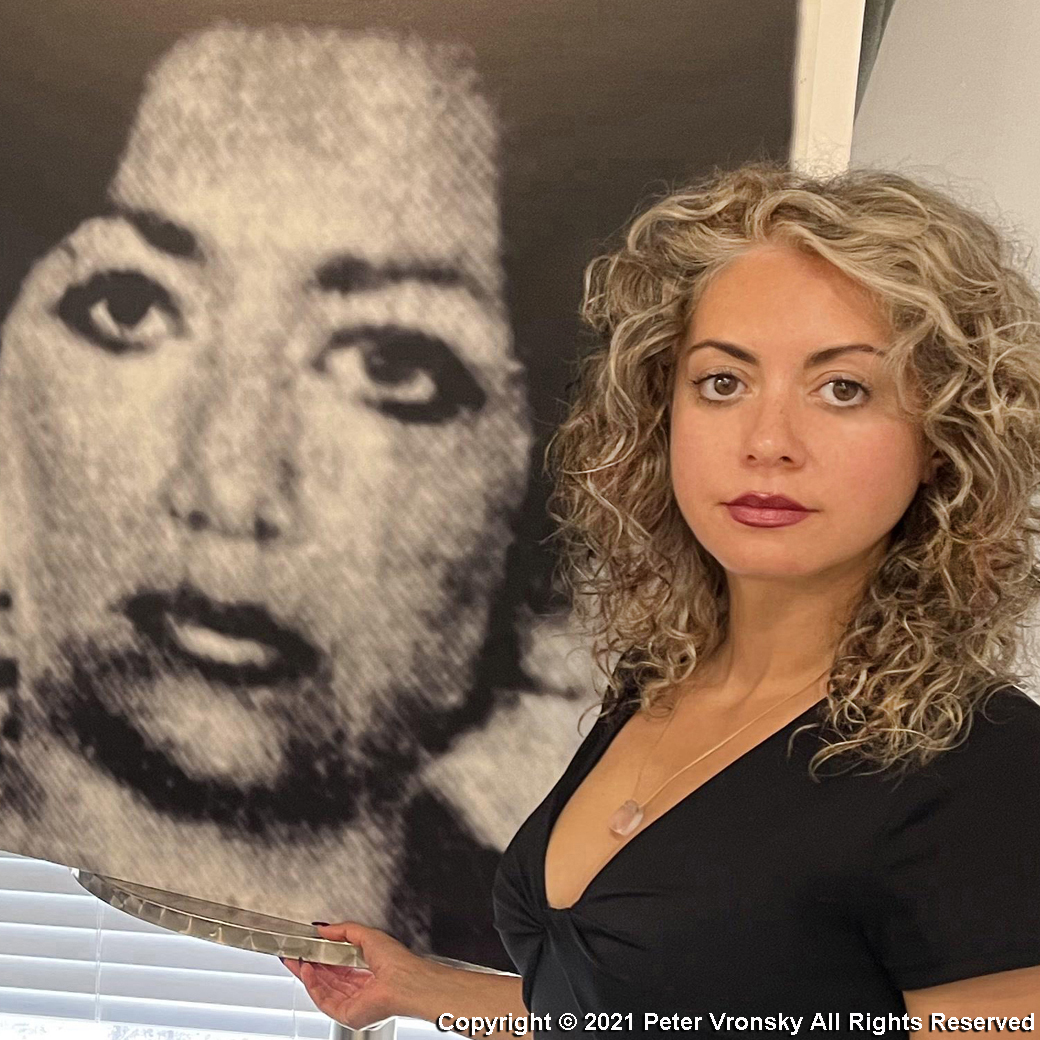

Copyright © 2021 by Peter Vronsky All Rights Reserved
THE HAUNTED HOUSE ON 10TH STREET
Sonia told me that Adeline had partly raised her too in the same cursed apartment in Queensbridge, and lived with her until Sonia was eighteen-years-old in the same damnation alley of a haunted ground in QB. Sonia got out before it swallowed her up like it did the other women who lived there.
Now that was dead haunted ground - the apartment in Queensbridge on 10th Street - four women under the same roof, one of them dead; a mother who lost her daughter, a daughter who lost her mother, and finally her daughter, Sonia, who never met her murdered grandmother, but was raised in the 'cult of her grandmother Lorraine's murder' on two opposite poles of the story: that of her own mother Emi, who lost her mother Lorraine when she was nine, and never fully recovered from it; and that of her great-grandmother Adeline who lost a daughter at the age of sixty-two, and had to mother her slain daughter's children had much to do with her great-granddaughter Sonia's upbringing, a rare thing having a great-grandmother.
All that, in that one same twilight zone of an apartment.
It's not just dead ground that can haunt you like dead people can; dead rooms and floors can do the same thing.
But, solving and closing the murder of Lorraine McGraw also had much to do with what did not happen next, when the "Make Jennifer famous on TV" Cottingham confession ad hoc task force went to work in March 2021, and Bergen County Prosecutor's Office (BCPO) along with their Chief of Detective Robert Anzilotti, came into the picture to fuck up and betray both Jennifer and all the New York detectives, including Detective Conor Fitzgerald's case of Lorraine McGraw, breaking every promise he made to the New York cops in order to get Cottingham to plea to his own 'Whale' before his retirement at the end of April 2021: to the 1974 cold case murders of Lorraine Kelly and Mary Ann Pryor which would never have been closed in 2021 without Jennifer Weiss.
NEXT PART 10:
2020 - NEW YORK BETRAYED BY NEW JERSEY: CLOSING THE KELLY & PRYOR 1974 COLD
CASE MURDERS IN BERGEN COUNTY
Part 11: 2022 - THE PASSION
OF SONIA RUIZ: SOLVING AND MEMORIALIZING THE MURDER OF LORRAIN McGRAW
Copyright ©2024 Peter Vronsky All Rights Reserved